Reading
Log For 2004
THE
HUNT FOR BIN
LADEN
Task Force Dagger (2003)
Random House, New York
Read entirely on 2004-01-04

- Robin Moore also wrote The Green Berets
and
composed
their
theme song.
- 6: In an explosion, keep your mouth open so the blast
won’t
rupture
your
eardrums.
- 8: Knowing the worth of the Special Forces, Warlord General
Dostum
threatened
to kill his soldiers and all of the soldiers’ families who
allowed any
American to come to harm.
- 19: The author thinks that the Green Berets could have won
in
Vietnam
if
they were used in their guerrilla capacity rather than their
counterinsurgency
capacity!
- 24: Massive bribes were given to officials from Uzbekistan
and
Tajikistan
for their cooperation.
- 26: While supporting the mujahadeen
against the Soviet
Army,
CIA
operative Billy Waugh saw Osama bin Laden almost every day.
- 27: In order to allow helicopters to take off at high
altitudes,
it’s
fuel
was pumped into a large rubber bladder on the ground. Once
airborne,
the fuel was sucked back on board.
- 28: While the work of the Special Forces was never widely
publicized, a
Ranger raid in Afghanistan made the evening news with night-vision
camera
footage.
- 29: A Delta Force raid on Mullah Omar’s house was
not publicized
at all.
- 81: The Northern Alliance was not familiar with how to take
prisoners.
TIGER 02 tried to teach them the 5 S’s:
- Search
- Silence
- Segregate
- Safeguard
- Speed in Evacuation (or Speed to the Rear)
- 116 - 117: The humanitarian food rations dropped in
Afghanistan
had
several
problems. Desiccant packages looked just like spices, but
ended
up
poisoning recipients. Because they were packed in low
altitudes,
the plastic coverings tore on impact, allowing the food to
spoil.
Headquarters did not believe there were any problems until retired
Green
Beret Keith Idema sent them digital pictures.
- 154 - 155: The notorious secret ISI (Pakistan Intelligence)
flights
from
Kunduz, which may have allowed high ranking Taliban to escape.
- 180: The book portrays “American
Taliban” John Walker Lindh as
actively
participating in the prison uprising, perhaps even translating between
the Taliban and CIA operative John Spann, while he was being
interrogated
and/or tortured.
- 216: While task forces RAMBO and TEXAS 12 were attacking a
Taliban
bridge
position, a confused yellow taxi pulled right into the line of
fire.
Both sides held their fire until the driver could drive out of the kill
zone:
“It was totally surreal.”
- 219: A devastating friendly-fire incident that nearly
killed
Hamid
Karzai
was caused by soldiers calling for airstrikes on their own
coordinates.
The troops were not trained well enough on their GPS system.
- 221: The Marines would not send in helicopters to help
evacuate
the
wounded.
- 288: The largest number of American casualties occurred
during
Operation
Anaconda, when Seven Rangers died trying to recover one SEAL, petty
officer
Neil Roberts, who had fallen from a helicopter.
- 319: An over-the-top description of G. W. Bush visiting
Walter
Reed
Army
Hospital:
After eight long years of neglect and
embarrassment,
the U.S. military finally had a real commander in chief.
ZODIAC
The Eco-Thriller (1988)
Paperback
Bantam Books, New York
2004-01-05 to 2004-01-06
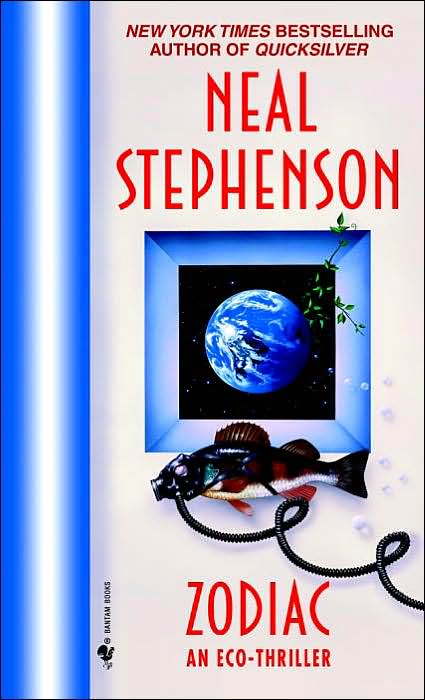
- Sangamon Taylor: A chemist, formerly working for industry
before
joining
GEE. Now he travels Boston by bike and Zodiac boat.
- 3: His huffing of nitrous follows his ethic:
“Sangamon’s
Principle,” I said. “The simpler the
molecule,
the better the drug. So the best drug is oxygen. Only two atoms. The
second-best,
nitrous oxide—a mere three atoms. The third-best,
ethanol—nine. Past
that,
you’re talking lots of atoms.”
“So?”
“Atoms are like people. Get
lots of them together,
never know what they’ll do. It is my understanding, Tess,
that you’ve
been
referring to me, about town, as a ‘Granola James
Bond’.”
Tess didn’t give a fuck.
“Who told you about that?”
“You come up with a cute
phrase, it gets around.”
“I thought you’d
enjoy it.”
“Even a horse’s ass
like me can detect sarcasm.”
“So what would you rather be
called?”
“Toxic Spiderman. Because
he’s broke and he never
gets laid.”
Tess squinted at me, implying that there
was a
reason
for both problems. Bart broke the silence. “Shit, man,
Spiderman’s got
his health. James Bond probably has AIDS.”
- 4: Or is he the Toxic Peter Parker?:
Peter Parker is the guy who got bit by
the
radioactive
spider, the toxic bug if you will, and became Spiderman. Normally
he’s
a nebbish. No money, no prestige, no future. But if you try to mug him
in a dark alley, you’re meat. The question he keeps asking
himself is:
“Do those moments of satisfaction I get as Spiderman make up
for all
the
crap I have to take as Peter Parker?” In my case, the answer
is yes.
And I hadn’t even told him the
truth. Actually, the
shit coming out of Basco’s pipe was a hundred
thousand times
more
concentrated than was legally allowed. The difference between pH 13 and
pH 8 was five, which meant that pH 13 was ten to the fifth
power—a
hundred
thousand times—more alkaline than pH 8. That kind of thing
goes on all
the time. But no matter how many diplomas are tacked to your wall, give
people a figure like that and they’ll pass you off as a
flake. You
can’t
get most people to believe how wildly the eco-laws get broken. But if I
say “More than twice the legal limit,” they get
comfortably outraged.
- Taylor specializes in using concrete to plug up pipes used
for
illegal
dumping.
- Rebecca: Reporter for The Weekly.
- Debbie: A co-environmentalist at GEE, who Taylor begins to
see.
- Alan Reading
- Dan Smirnoff: An eco-terrorist.
- Hank Boone: Another eco-terrorist.
- 88:
Talking to cancer victims never makes me
feel
righteous,
never vindicated. It makes me slightly ill and for some reason, guilty.
If people like me would just keep our mouths shut, people like him
would
never suspect why they got cancer. They’d chalk it up to God
or
probability.
They wouldn’t die with their hearts full of venom.
- 115: While on an island made of trash, Taylor tells some
Pöyzen
Böyzen
fans that he is looking for PCBs, but they thought he said he was
looking
for PCP.
- 160: Electrical transformers have PCBs, which are extremely
toxic.
- 172: His advice for PCB exposure:
“Activated
charcoal,” I said. “Go home and buy some
aquarium charcoal. Grind it up fine, heat it up, and eat it. Give
yourself
an enema.”
- When the PCBs disappear as he gets closer to the source, he
discovers
that
a genetically-modified bacteria has been used to convert them to inert
salt. However, another type of bacteria was modified to do
the
opposite.
Eventually, they could turn all the salt in the ocean to chlorine.
THREAD
OF THE
SILKWORM
(1995)
Paperback
BasicBooks, New York
2004-01-07 to 2004-01-10
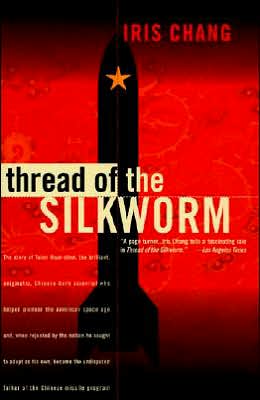
The story of Tsien
Hsue-shen, the brilliant, enigmatic, Chinese-born scientist
who
helped
pioneer the American space age and, when rejected by the nation he
sought
to adopt as his own, became the undisputed father of the Chinese
missile
program.
- 3: His name means “study to be wise”.
- 5: His mother, Chang Langdran, was given an education in
the Five
Classics:
the Book of Rites, the Book of History, the Spring and Autumn Annals,
the
Book of Poetry, and the Book of Changes.
- 17: In the early 1920’s, several guests came to
Beijing to
influence
the
Chinese educational system: John Dewey, Bertrand
Russell, Albert
Einstein,
the Indian poet Rabindranath Tagore.
- 30: In January 1932, Japanese planes bombed the Zhabei
district
of
Shanghai
after a group of Japanese Buddhist priests were beaten.
- 86: Because of the far-out connotation of the word rocketry,
Caltech
started using the euphemism jet propulsion instead.
- 98: L.
Ron Hubbard moved
into
the
mansion of John
Parsons, who was notorious for throwing wild,
black-magic
inspired parties.
- 179: In the 1950s, FBI agents followed the Weibaum family
to the
ice
cream
parlor because they were convinced that the flavors picked were part of
some secret code.
- 222: On October 27, 1966, the Chinese tested a nuclear bomb
and a
new
rocket
design simultaneously.
- 227: The first Chinese artificial satellite was launched on
April
24,
1970.
- 229: China detonated its first nuclear bomb on October 16,
1964.
- 243: A naïve article by Tsien had disastrous
consequences.
According
to Xu Liangying:
“Tsien, who know nothing about agriculture,
wrote this
article to give
Mao’s programs scientific justification. After this hit the
newspapers,
Mao followed through with his policies. This article had a terrible
influence on Mao. And yes, it had an impact on the famine that
followed, in
which 30 to 70 million people died.”
- 256: In the 1970s and 1980s, Tsien became swept up in the
craze
of UFOs
and ESP.
GALILEO’S
REVENGE
Junk Science In The Courtroom (1991)
Paperback
BasicBooks, New York
2004-01-10 to 2004-01-12
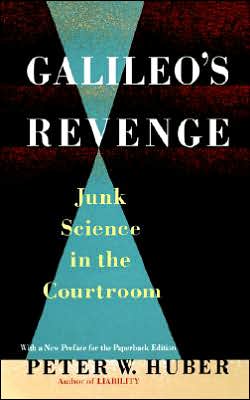
- 14: The 1923 federal appellate court ruling in Frye
v. United
States
allowed experts in court only if their testimony was founded on
theories,
methods, and procedures “generally accepted” as
valid among other
specialists
in the same field.
- 15: However, the Federal Rules of Evidence in 1975
disregarded Frye
and allowed for expert testimony:
If scientific, technical, or
other specialized knowledge will assist
the trier of fact to understand the evidence or to determine a fact.
- 25: The scientific world was excited in the early 20th
Century
when René Blondlot “discovered” N
rays. Despite being a
product
merely of imagination, the French journal Comptes rendus
published
54 papers on N rays in 1904, while only publishing 3 papers on X rays.
- 42: The idea that cancers are caused by trauma had less to
do
with
medicine
than worker’s compensation laws. Two thousand books
and papers
were
published on the subject in Germany in the latter 19th
Century.
- 45: In dubio pro laeso = When in doubt,
favor the injured.
- 68 - 69: Incidents of “sudden
acceleration” in Audi cars,
popularized
by 60
Minutes, were found to be physically impossible.
When the
brake
is activated, the engine cannot summon enough power to move.
Although
it is difficult to believe, all these accidents were most likely caused
by the driver mixing the brake and accelerator.
- 69 - 70: Clarence Ditlow leads the Center for Auto Safety
(CAS),
an
advocacy
group founded by Ralph Nader in 1980. When cases against Audi
started
to become more difficult to win:
Ditlow, more royalist than the king,
would continue
to insist that sudden acceleration was a diabolical (though as yet
unexplained)
engineering mystery. Most plaintiffs’ lawyers had more sense.
Indeed,
they
had understood from the beginning that being persistent mattered more
than
being consistent. In litigation you win some, you lose some, the
profit’s
in the volume, and the key is to keep on plugging.
- 78 - 80: Problems such as cerebral palsy were thought to be
caused by
trauma
during birth, leading to lawsuits against doctors. Electronic
fetal
monitoring (EFM), which traces the heartbeat of a baby during delivery,
was introduced in 1972 to determine if this was the case.
However,
the EFM charts were subject to interpretation, leaving the issue just
as
murky as before.
- 80 - 81:
Today, this line of attack has become
one of the
most
spectacularly lucrative enterprises known to lawyers, quite possibly
the
single largest revenue raiser in all of medical malpractice. About four
million babies are born healthy every year. Ignore them. Some four
thousand
babies a year are born with cerebral palsy. Ignore most of them too.
But
four hundred (say) of those had a complicated delivery. These are the
cases
most likely to arrive in court. And there, the facts are reviewed
chronologically,
so that the jury sees the undisputed trauma first, the disputed
negligence
second, the undisputed cerebral palsy third. It is a perfect setup for
misinterpreting sequence as cause. Litigated a mere forty times with a
one-in-two success rate, that setup can yield a small firm $50 million
or so, on an upfront investment for expert witness fees and
administrative
costs of maybe $5 million at most.
- 111 - 113: Charlotte Brontë literally died of
pregnancy in
1855.
The FDA approved Bendictin as therapy for morning sickness in
1956.
Over 30 years, Bendictin had been used by 30 million pregnant
women.
William McBride declared it to be the cause of birth defects, like
thalidomide.
- 119 - 120: 700 Babies with vastly different types of birth
defects were
lumped into a massive class action suit by federal district Judge Carl
B. Rubin in Cincinnati. The trial began ion February 4, 1985
with
more than 1,100 plaintiffs. The judge was innovative in his
methods:
To the horror of the
plaintiffs’ lawyers, however,
Judge
Rubin resolved to run a trial, not a casino. The trial was going to
address
Bendictin, so Rubin banned the word “thalidomide”
from his courtroom.
The
trial was going to turn on science, not sympathy, so Rubin banned all
visibly
deformed children. When seventeen parents and seven children staged a
protest,
Rubin ordered extra security guards, set up closed-circuit televisions
for the demonstrators, and retained a staff of nurses to care for the
handicapped
children while their parents attended the trial. Finally, Rubin
declared
that the trial would be held in three separate stages. In the first,
the
jury would decide only whether Bendectin can cause birth defects at
all.
Only in the subsequent stages—if they were needed at
all—would the jury
consider whether specific children had been injured, and if so what
they
deserved in compensation. There would be no playing on jurors
sympathies
until some basic scientific questions had been resolved.
A total of nineteen experts testified.
Both Alan
Done and William McBride appeared for the plaintiffs. On March 12,
1985,
it took the five women and one man on the jury just four and a half
hours
to conclude that Bendectin does not cause birth defects.
- 127: Merrell removed Bendectin from the shelves on June 9,
1983.
In the subsequent years, there has been no decrease in the incidents of
birth defects.
- 128:
No other U.S. pharmaceutical
company is ever going to expose itself
to such legal risks either, so private research into pregnancy-related
drugs has virtually stopped. “If you’re suffering
from morning
sickness,”
runs one bitter joke in the industry, “go see your
lawyer.”
- 145: In a case where a teacher was fired for having
tuberculosis,
the
Supreme
Court finally ruled in 1987 that citizens enjoy the right to be
protected
from “discrimination on the basis of mythology” and
the “complex and
often
pernicious mythologies about the nature, cause, and transmission of
illness.”
- 146: The problem comes from whether this counts as a
handicap:
Lewis Carroll could hardly have devised
a better
ending
for the chronicles of tuberculosis in court. You are not
contagious,
and therefore not in fact handicapped. The common citizen believes that
you are contagious, however, and you are therefore
fired. So
the
Supreme Court of the United States certifies that you are
handicapped,
by virtue of the common citizen’s irrational prejudices.
Which means
that
you are legally entitled to be treated as if you were not
handicapped.
Which you aren’t anyway.
- 168: Joan Berry claimed that Charlie Chaplin was the
father
of
her
daughter.
However, Joan had Group A blood, and her daughter had Group B
blood.
Her father must have had either Group B or AB, but Chaplin was Group
O.
This made no difference in the case.
- 198 - 199: Should judges believe a scientist based on
credentials?
This is dangerous because:
Strings of letters appended to
last names do provide a useful
initial
screen against professional incompetence, but only a very course one.
Even
yesterday’s stellar achievement offers little assurance that
today’s
opinion
is correct: many a great scientist takes off sooner or later on some
foolish
frolic. Isaac Newton, for example, ended up in alchemy. Johannes
Baptiste
van Helmont, the seventeenth-century scientist who invented both the
term
and the concept of a “gas,” later extolled the
curative powers of
magnetic
forces. David Starr Jordan, one-time president of Stanford University,
who coined the term sciosophy (“shadow
wisdom”) to describe the
junk science of his day, was a dyed-in-the-wool eugenicist. The modern
patron of clinical ecology in a Harvard-trained, board-certified
allergist.
Individuals change; yesterday’s competent medical student or
even
Nobel-caliber
chemist can become tomorrow’s crank.
- 208 - 209: Richard
Feynman
proposed that expert witnesses make a declaration at the outset:
“In keeping with my professional
responsibilities, I will
promptly
publish
anything of scientific note that I may learn in our consultations,
regardless
of whose legal interests my findings favor.”
- 217: Galileo is said to have muttered, “eppur
si muove” =
“nonetheless
it does move”
A
LEG TO STAND ON
(1984)
Paperback
Touchstone, New York
2004-01-11 to 2004-01-15
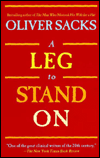
- While hiking in England in 1974, Sacks seriously
injures
his leg
(running
away from a bull). Since nobody knew to look for him, his
rescue
that day was very lucky. The descriptions of his injury and
painful
recovery will make anyone cringe.
- 28 b: Medical terminology differences between England
and
the
U.S.: A
houseman
is an intern, a registrar is a resident, surgeons are called
“Mr.”
rather
than “Dr.”, and the chief nurse on a ward is called
the Sister.
- 57: He wrote about “The Man with the Missing
Leg” 15 years before
his
accident.
- This book was filled with hyperbole, everything was
either
“infinite”,
“monstrous”, “instant”, etc.
- 183: The Afterward describes another fall in 1983 where
he
seriously
injures
his other leg.
- 191:
I repent, I retract, my Kantian
aberration now; but I was driven to
it, I think, by the limitations of physiology.
CONFUSIÓN
DE CONFUSIONES (1688)
Paperback
Wiley Investment Classics, New York
2004.1.27 – 2004.1.29
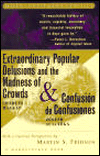
Whoever comes to know Joseph Penso de le
Vega’s Confusión
de
Confusiones will recognize at once that he is concerned with
a
literary
oddity. Here is a book written in Spanish by a Portuguese Jew,
published
in Amsterdam, cast in dialogue form, embellished from start to finish
with
biblical, historical, and mythological allusions, and yet concerned
primarily
with the business of the stock exchange and issued as early as 1688.
Such
a volume obviously requires a good deal of explaining.
Shareholder: I
really must say that you are
an
ignorant person, friend Greybeard, if you know nothing of this
enigmatic
business which is at once the fairest and most deceitful in Europe, the
noblest and most infamous in the world, the finest and most vulgar on
earth.
It is a quintessence of academic learning and a paragon of fraudulence;
it is a touchstone for the intelligent and a tombstone for the
audacious,
a treasury of usefulness and a source of disaster, and finally a
counterpart
of Sisyphus who never rests as also of Ixion who is chained to a wheel
that turns perpetually.
- 158 - 159: The Shareholder’s advice on
speculation:
Never give anyone the
advice to buy or sell shares,
because
where
perspicacity is weakened, the most benevolent piece of advice can turn
out badly.
The second principle: Take
every gain without
showing remorse about missed profits, because an eel may
escape
sooner
than you think. It is wise to enjoy that which is possible without
hoping
for the continuance of a favorable conjuncture and the persistence of
good
luck.
The third principle: Profits
on the exchange
are the treasures of goblins. At one time they may be
carbuncle
stones,
then coals, then diamonds, then flint-stones, then morning dew, then
tears.
The fourth principle: Whoever
wishes to win in
this game must have patience and money, since the values are
so
little
constant and the rumors so little founded on truth. He who knows how to
endure blows without being terrified by the misfortune resembles the
lion
who answers the thunder with a roar, and is unlike the hind, who,
stunned
by the thunder, tries to flee. It is certain that he who does not give
up hope will win, and will secure money adequate for the operations
that
he envisaged at the start. Owing to the vicissitudes, many people make
themselves ridiculous because some speculators are guided by dreams,
others
by prophecies, these by illusions, those by moods, and innumerable men
by chimeras.
- 176: The Shareholder gives a history of Amsterdam:
The Dam is a square which is faced by
The Palace
[i.e.,
the town hall]. In Dutch Dam means a dyke against
the floods,
for
at this place once a dyke had been constructed in order to protect the
town against the Amstel, the river from which the town got its name, as
Amsterdam was originally called Amstel Dam.
Merchant: I on my
part thank you for the
instruction.
I esteem business but hate gambling. I have a notion that my faculties
do not suffice for such complicated transactions. If I nearly lost my
sense
when I wanted to learn about the speculations, you may conclude of what
importance to me is the conduct of Exchange transactions. It is
possible
that I shall become a holder of shares and shall deal [in shares] in an
honest way, but I am very sure that I shall never become a speculator.
Philosopher: I will
take the same course
because I am too old to defy dangers and to endure storms. I shall keep
my shares until it shall please God that [after the recent downfall of
the prices] I can get out of them in peace, for I will only save myself
and not gather wealth.
All schools of philosophy teach
that the
soul
is nobler than the body, life nobler than death, and the existent
nobler
than the non-existent. But, as for the stock exchange, I approve the
paradoxical
opinion of the Platonic musician that the non-existent is better than
the
existent. I think it much better not to be a speculator, [and in making
that statement] I have in mind real speculation, not the honest
business
in shares, for what is fair in the latter is dubious in the former.
LIES
ACROSS AMERICA
What Our Historic Sites Get Wrong (1999)
Paperback
The New Press, New York
2004-02-02 to 2004-02-14

- Besides pointing out bona fide factual errors on
historic
monuments,
the
author takes issue with the euphemistic terminology of historical
injustices.
He makes numerous comments about European
“discovery” of inhabited
lands
as well as the “state’s rights”
justification of the Civil War.
- 37: Kiswahili speakers of east and central Africa
divide
the
deceased
into
two categories:
- sasha = the recently departed whose memory remains in
the
living.
- zamani = revered ancestors from long ago.
- 52: Mount McKinley was known to the natives as Denali.
- 99 - 102: Correct names of Native American
tribes. Many of
the
names
used by European settlers were derogatory terms used by rival
tribes.
Most of the names translate as something like “we the
people”.
- Navajo means “thieves” to rival
Tewa
Pueblo Indians; prefer
Diné.
- Apache means “enemies” to
Zunis. Related linguisticly to
Navajos,
they also called themselves Diné.
- Papagos of southern Arizona means “bean
eaters” to nearby
Pimas; prefer
Tohono O’otam = “desert people”.
- Pimas, another southern Arizona tribe, means
“I
don’t know”,
their
reply
when asked their name by a Spanish explorer; prefer Akheemult
O’odham =
“river people”.
- Anasazi means “ancient enemies”
to
Navajo.
- Eskimo means “those who eat raw
flesh” to Crees; prefer Inuit.
- Sioux was shortened from Nadouwesioux, meaning
“little snakes”
or
“enemies”
to Ojibwes; prefer Dakotas or Lakotas.
- Ojibwes, or Chippewas, refer to themselves as
Anishanabes
=
“people of
the creation”.
- Mohawk means “cannibal” in
Algonquian; prefer Kaniegehagas =
“people of
the place of flint”.
- Salish were called Flathead Indians by the British.
- Two groups were called “Gros
Ventres”
= “big bellies” by the
French.
- Nimipus were called “Nez
Percés” = “pierced noses” by
the French.
- Lenape were named after De La Ware by the British.
- 103: Voltaire quote:
If we believe absurdities, we shall commit atrocities.
- 113 - 115: The National Mining Hall of Fame and Museum
in
Leadville,
Colorado
is supported by mining corporations and does not mention how terrible
working
conditions led to labor unions, nor famous labor leaders including:
- Big Bill Haywood helped found the Industrial Workers
of
the
World
(IWW).
Clarence Darrow won his acquittal of assassinating the former governor
of Idaho. He was sentenced to twenty years in jail for
sedition
during
the Woodrow Wilson administration and fled to the Soviet Union.
- IWW leader Joe Hill was executed in Utah in 1915.
- 137 - 141: Typical Spanish-American War monuments list
the
dates
of the
war from 1898 to 1902. A better description would be from May
1,
1898 to August 13, 1898. At that point, the U.S. had
destroyed
the
Spanish Pacific fleet in Manila Bay, compelled the the surrender of
Santiago
de Cuba and taken Puerto Rico with only 379 American deaths and 1,604
wounded.
However, hostilities in the Philippine-American War
began on
February
4, 1899 and Theodore Roosevelt declared victory on July 4,
1902.
Serious incidents continued as late as 1916. Of the 125,000
troops
sent to the Philippines, about 10,000 died; 4,234 deaths were in combat
and 2,818 were wounded.
- 195 - 197: Texas has more historical markers than the rest
of the United States put together. But the history is selective.
The official state markers might look less like “a big joke”
if Texas marked the sites whee these events happened, none of which is
currently commemorated on the landscape:
- Reconstruction violence (not one site marked).
- The notorious Brownsville race riot of 1906.
- The hundreds of lynchings in Texas, including the killing of at least
eighteen African Americans in Slocum on July 29-30, 1910.
- Sweatt v. Painter,
the first successful school desegregation lawsuit in modern Texas
history and an important precursor in 1950 of Brown v. Board of Education.
- The first woman juror in Texas, in 1954.
- The founding of La Raza Unida, the first major Chicano political
party, in Crystal City in 1969.
These are all matters of statewide if not national importance.
249: The Scottsboro Boys were accused of raping two
White
women
on
March
25, 1931. Despite there being no evidence that rape actually
occurred,
the nine Black defendants served a combined total of more than one
hundred
years in jail.
298: Richmond does not mention one of the great female
spies of
all
time,
Elizabeth Van Lew, who worked for the Union during the Civil War.
319: Quote from poet John
Harington:
Treason doth never prosper,
What’s the reason?
For if it prosper,
None dare call it Treason.
- 328: Panels at the Thomas
Jefferson
Memorial, dedicated in 1943, take his quotes out of context.
- The first panel misquotes the Declaration of
Independence
downplaying
the
unity of the 13 Colonies.
- The second panel, on religious freedom, takes a
sentence
written to
James
Madison out of context, wrongly implying that he thought absolute codes
came from religion:
I know but one code of morality for men whether
acting singly or
collectively.
- The third panel falsely implies that Jefferson was
against
slavery.
They appear to attribute liberty to God, when they are actually about
taxes
and the impact of slavery on Whites.
- 331: Polish Revolutionary War hero Thaddeus Kosciusko
made
Jefferson
the
executor of his will, which stipulated using $17,000 in securities to
buy,
free, and educated young African Americans. Jefferson used
the
money
for other purposes.
- 352: The Cannon-Johnson Gang ran the largest kidnapping
ring in
the
history
of the U.S., stealing free Blacks from the North and selling them into
slavery in the Deep South.
- 363: The winter encampment at Valley Forge was not
nearly
as bad
as it
is portrayed.
- 367: President James Buchanan was thought to have a
homosexual
relationship
with William Rufus King, but this is not a topic of discussion at his
house,
Wheatland, in Lancaster, PA.
- 369 - 370: Lincoln was called “Honest
Abe” because the previous
Buchanan
administration was so corrupt.
- 380: Wilson secretly sent Americans to fight alongside
the
Russian
Whites,
who had little enthusiasm.
- 381 - 382: One of the fastest policy reversals in U.S.
military
history
was the “strict legalistic interpretation” of the
international law
that
required submarines to allow crew and passengers to evacuate targeted
ships.
The conduct of German submarines in WWI was one of the reasons that
America
declared war.
- 406: Sociological terms on human reactions to complex
moral
situations:
- wertrationalität =
“value rationality” is when
people
act in
accord with their basic values.
- zweckrationalität =
“technical rationality” is
when
they act
in accord with the organization in which they belong, such as
“only
following
orders”.
- 408: Gregory Peck starred in the film version of Laura
Z.
Hobson’s 1947
novel Gentleman’s Agreement,
about the unwritten
agreement
not to sell real estate to Jews in Darien, Connecticut.
Darien
used
to be a “sundown town” which forbade African
Americans and Jews to
remain
overnight.
- 417: Helen Hunt Jackson wrote A
Century
of Dishonor
(1881),
a scathing exposé of U.S. policy against Native Americans.
- 425: The phrase, “That
takes
the cake!” comes from the
outrageous
Cakewalk performances on antebellum slave plantations.
- 452: On Senator John A. Logan:
Logan was born in southern
Illinois in 1826 and like most people of
the region and time became a Democrat partly because he agreed with the
party’s white supremacy. His experience during
Sherman’s March
transformed
him as he came to know African Americans and realized they were not
inferior
beings. Becoming an equalitarian, he transferred to the Republican
Party
and helped manage the impeachment of President Andrew Johnson. Johnson
was impeached (but not convicted) partly because he refused to carry
out
Congressional mandates for equal rights for ex-slaves
WAY
OUT THERE IN
THE
BLUE
Reagan,
Star Wars And The
End Of
The Cold War (2000)
Hardcover
Simon & Schuster, New York
2004-02-18 to 2004-02-22

- The title comes from Arthur Miller’s Death
of a Salesman.
- 19: President Reagan gave his famous “Star
Wars” speech on March
23,
1983
to make ballistic missiles “impotent and obsolete”,
much to the
surprise
of virtually everyone in Washington, D.C.
- 20: On July 31, 1979 (before becoming president) Reagan
toured
the
underground
NORAD command center at Cheyenne Mountain. Answering a
question,
General James Hill said that the personnel would only be able to watch
the monitors helplessly if a single missile were launched at an
American
city. Martin Anderson claims that this made a bit impression
on
Reagan.
- 22: Reagan often quoted from movies without
attribution.
For
example,
his retort to Bush that “I’m paying for this
microphone” was from a
film
called State of the Union. He sometimes
cited movie plots
as fact, such as A Wing and a Prayer.
- 30: In 1954 Reagan agreed to be a spokesman for General
Electric
on TV
and as a traveling speaker. In the late 1950s, the speeches
became
more right wing, denouncing New Deal measures such as rural
electrification
and Social Security. These speeches were full of anecdotes
and
statistics
about the inefficiencies of communism, but Reagan never provided
sources.
Years later, when meeting with Gorbachev, Reagan repeated some of these
anecdotes and jokes inappropriately.
- 53: Testifying during an anti-trust trial of Music
Corporation of
America
(MCA), Reagan exhibited “forgetfulness”.
- 95: Nuclear strategy as chess:
This tower of conditionals resting upon
a
hypothetical
“window of vulnerability” struck some defense
experts as a Rube
Goldberg
contraption. Lawrence Freedman, the British historian of nuclear
strategy,
wrote that the methodology involved reminded him of Stephen
Potter’s
advice
to the chess player in Gamesmanship: if you want to
one-up a
more
experienced opponent, make three moves at random and then concede
defeat,
explaining that your situation is hopeless given the brilliant
checkmate
he will make twenty moves hence.
In the presidential debate on
October 28 Reagan talked about his
devotion
to “world peace,” and when Carter said, quite
accurately, that his
opponent
had begun his political career campaigning against Medicare, Reagan
clinched
the debate, as far as many were concerned, by shrugging his shoulders,
looking over at his opponent forlornly and saying, “There you
go
again.”
- 117: Because each MX missile was to powerful powerful,
they
would
be
likely
targets for a first strike. Defense Secretary Harold Brown
proposed
in 1979 to randomly move them along a “racetrack”
that would ring six
thousand
square miles.
- 135: Problems with Edward Teller’s X-ray
laser
pointed out by
Daniel
Graham:
Instead he attacked the concept
on political and tactical grounds.
The
American public, he said, would never stand for a nuclear weapon in
space—and
besides, this weapon had a fatal flaw. “It may be a technical
marvel,”
he told Teller, “but it involves a military paradox. If
someone fires a
weapon at this kind of satellite, its only reaction is to destroy
itself
or be destroyed. It can only protect itself by blowing itself
up.”
- 138: When two Navy fighters shot down two Libyan jets
on
August
19,
Edwin
Meese did not bother to wake Reagan.
- 144 & earlier: By DoD rules, contractors are
not
allowed to
testify
about the “necessity” of the Strategic Defense
Initiative.
- 158:
According to [David] Stockman [in The
Triumph
of Politics (1986)], the administration’s
decision to spend
$1.5
trillion on defense over five years owed in large part to his own
mistake
in arithmetic.
- 159: Stockman had agreed with Frank Carlucci and
William
Schneider to
increase
the defense budget by 7% a year in real dollars base on 1982, while the
Reagan campaign figures were all based on 1980. Stockman had
forgotten
that Congress had raised the 1981 budget by 9% and Reagan had added
more,
so the baseline had started at $222 billion, instead of $142 billion as
he had assumed.
It meant that the defense budget
would grow by 160 percent in just
six
years. Stockman stormed about his office, but by that time the
defense-budget
figures were out and there was nothing he could immediately do.
- 170: When Reagan was shot on March 30, Haig announced
from
that
White
House
press room that, “As of now, I am in control
here.” It turns out
that there was good reason for him to do so because Weinberger might
have
raised the Defcon and the White House press secretary was not sure
whether
the government was running. Haig had meant only to convey
that
the
government was functioning as normal, but he was breathless from
running
up the stairs.
- 223 - 224 ftnt.: National Security Council member
Leslie
Lenkowsky was
appointed director of USIA in September 1983. He was never
confirmed
because he lied about the existence of a blacklist of 95 people
(including
Walter Cronkite, Paul Samuelson, Senator Gary Hart, and Coretta Scott
King)
who would not be permitted to go on USIA trips. He is famous
for
testifying:
“I’m prepared to stand by what I
meant to
say.”
In a hearing of the Senate Foreign
Relations
Committee
in April 1984, administration officials, questioned closely about the
Star
Wars concept, acknowledged that a system capable of shooting down
Soviet
missiles in the boost phase would have to be triggered on such short
notice
that the command decision might have to be made by computer.
“Well, that would argue that
in the 1990s we should
run R2D2 for President,” Senator Paul Tsongas (Democrat of
Massachusetts)
said, referring to the robot in the movie Star Wars.
“[At
least]
he’d be on line all the time.”
“Has the President been
informed that he’s out of
the decision-making loop?” Tsongas continued.
“I most certainly have not
[informed him],” George
Keyworth replied.
Robert S. Cooper, director of DARPA,
chimed in with
the suggestion that the President could carry a strategic-defense
trigger
“even into the bathroom.”
Senator Joseph Biden (Democrat of
Delaware) then
asked if the proposed defensive weapons might be fired
accidentally—provoking
the Soviets to launch an attack. “Now, let’s assume
that it was a
mistaken
judgment,” he began.
“We’re not ready to
assume that,” Dr. Cooper
interrupted,
“because we don’t know but what in that time period
we couldn’t create
technologies that would not make such a mistake possible.”
“O.K.,” Biden said.
“You’ve convinced me that I
don’t want the program in the hands of a man like
you.”
Richard Perle came to Cooper’s
defense. “Frankly,”
he said, “I think that question of Presidential intervention
or any
other
intervention is a minor, second-order issue when the real issue is
whether
you do or do not stop the destruction of the United States.”
“How does the President feel
about your viewing
him as a minor, second-order level of decision-making?”
Tsongas asked.
“I said the decision is a
minor decision because
it does no harm if it turns out there is not an attack, and if there is
an attack . . .”
“Some of us believe that
nuclear war in not a minor
decision,” Tsongas said.
- 250: Eventually Senator John Glenn (Democrat of Ohio)
broke
out
in
exasperation
his skepticism that the technology was available yet anyway.
- 292: SDI advocates became re-interpreting the
Anti-Ballistic
Missile
(ABM)
Treaty to allow for the deployment of “future
technologies”.
Despite
numerous attempts by Congress to reinforce the “restrictive
interpretation”,
the “broad interpretation” kept cropping up from
the Reagan
Administration.
- 332: In the spring and summer of 1986, the U.S. made
several
provocative
moves against the Soviet Union and Libya.
- 382: The Iran-Contra arms-for-hostages deal was
ineffective
on
its face
because while three Americans were released, three more were abducted
to
serve as bait for more weapons.
- 408: Gorbachev tells his assistants that the they will
only
have
to
spend
10% as much as the Americans spend to overcome SDI. The
Soviets
never
spent much to overcome SDI, because the U.S. never fielded a system to
overcome.
- 409: Gorbachev allows Andrei Sakharov to return to
Moscow
from
internal
exile on December 23, 1986. He criticized
Gorbachev’s tying
offensive-arms
reduction agreements to stopping SDI research. See “EVERY
MAN SHOULD TRY” (1999)
- 418: Months after the Marines had confessed allowing
penetration
of the
U.S. Embassy in Moscow, the Naval Intelligence Service concluded that
they
had been pressured into confessing falsely. There was no
serious
security breach.
- 422: On June 12, at the Brandenburg Gate in Berlin,
Reagan
demands that
Mr. Gorbachev, “tear down this wall!”
- 426: After years of stalling, the INF treaty only
reduced
the
number of
nuclear warheads by 4%.
- 428:
In his opening remarks Reagan said,
“We have
listened
to the wisdom of an old Russian maxim. The maxim is doverai,
no
proverai—trust
but verify.”
“You repeat that at every
meeting,” Gorbachev
interjected,
chuckling.
“I like it,” Reagan
answered, and the room erupted
in laughter.
- 474 - 475: CIA estimated that the Soviet Union did not
bother to
match
U.S. increases in military spending.
TRUST
US, WE’RE
EXPERTS!
How Industry Manipulates Science And Gambles With Your
Future
(2001)
Hardcover
Jeremy P. Tarcher / Putnam, New York
2004-02-22 to 2004-02-24
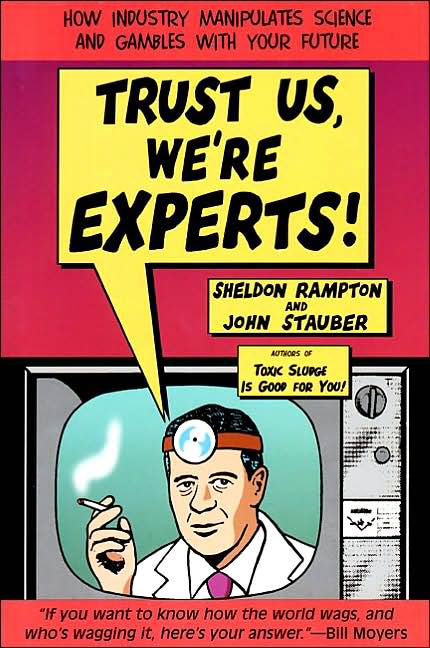
- 23: PR firms distribute video news releases (VNRs)
which
are run
as
news
stories by television stations who have lost reporting budgets over the
years.
- 45: Edward L. Bernays was the “father of
public
relations”:
“Mr. Bernays has . . . created
more institutes,
funds,
institutions, and foundations than Rockefeller, Carnegie, and Filne
together,”
observed the Institute for Propaganda Analysis, a nonprofit educational
organization that flourished in the years following World War I.
“Typical
of them was the Temperature Research Foundation. Its stated purpose was
‘to disseminate impartial, scientific information concerning
the latest
developments in temperature control as they affect the health, leisure,
happiness, and economy of the American people.’ A minor
purpose—so
minor
that rarely did Mr. Bernays remember even to mention it—was
to boost
the
sales of Kelvinator refrigerators, air-condition units, and electric
stoves.”
- 46 - 51: General Electric (formerly, the Edison General
Electric
Company,
before J. Piermont Morgan took it over) threw an elaborate party to
honor
an ailing, 82 year old Thomas Edison, and divert public attention away
from inquiries into its monopolistic practices.
Light’s Golden
Jubilee
was held on October 21, 1929, three days before Black Thursday.
- 51: British economist John Maynard Keynes lost the
equivalent of
£1
million in the Depression.
- 56: Karl Popper defines the main difference between
science
and
pseudoscience
to be that the former is “falsifiable”.
- 75 - 77: Perhaps thousands of miners died from
silicosis by
sandblasting
at Hawk’s Nest, West Virginia in the 1930s, yet the tragedy
is largely
forgotten.
- 106: The Public Relations industry uses the formula of
Peter
Sandman to
determine the fallout from bad publicity: “Risk equals hazard
plus
outrage.”
- 176 - 177: Unlike its traditional creation method,
genetically
engineered
L-tryptophan caused a toxic byproduct which led to severe problems in
consumers
who bought it at “health food” stores.
- 220: Typical conflicts of interest:
The public today is bombarded with
scientific
information
regarding the safety and efficacy of everything from drugs to seat
belts
to children’s toys. Eating garlic bread brings families
closer
together,
says research sponsored by Pepperidge Farms bakeries, which makes
frozen
garlic bread. Eating oat bran lowers cholesterol, according to research
sponsored by Quaker Oats. Eating chocolate may prevent
cavities,
says the Princeton Dental Resource Center, which is financed by the
M&M/Mars
candy company and is not a part of Princeton University. A daily glass
of red wine reduces your risk of heart disease, say the doctors hired
by
the liquor industry. Chromium picolinate taken as a dietary supplement
will help you burn off fat, says the dietary supplement industry. Zinc
lozenges might shorten the duration of the common cold, reports a
researcher
who happens to hold 9,000 shares of stock in a zinc lozenge company.
- 223 - 224: Discusses the book GALILEO’S
REVENGE (1991) by Peter
Huber,
and disputes the cost of liability lawsuits, but does not refute any of
the specific incidents convincingly.
- 226 - 227: The scare from spraying apples with alar in
1989.
- 237: The libertarian magazine Reason
receives funding
from
Philip
Morris.
- 248 - 249: “Junk Science” crank
Steven
Milloy.
STAR
CORPS
Book One Of The Legacy Trilogy (2003)
Paperback
EOS, New York
2004-02-24 to 2004-02-25

- Years after SEMPER
MARS (1998), LUNA
MARINE (1999), and EUROPA
STRIKE (2000), Marines have been sent to the
planet Ishtar, to
investigate the Ahannu, a reptilian race with access to ancient
technologies.
Humans have been slaves to the Ahannu for thousands of years.
Rather
than fight for their freedom, they protect their masters from their
“liberators”
with a religious frenzy.
- John Esteban (Garroway): His great-grandfather is
“Sands of Mars
Garroway”
and his grandmother is Caitlin, who he read about in Ocher
Sands.
- Gavin Norris: Corporate troubleshooter, whose mission
is to
- Noumenon = opposite of phenomenon, and therefore not
reality.
Synonym
for cyberspace.
- 83: Marine terminology: floor = deck, ceiling =
overhead,
door =
hatch,
stairs = ladder, bed = rack, pants = trousers, hat = cover, upstairs =
topside, downstairs = below deck, room = compartment, bathroom = head.
- 229: Not all the Marines were informed of the high
death
rate
during
the
voyage in suspended-animation, about 3%. Due to relativistic
effects
and suspended animation, Earth will age 10 years, but the crew will
only
age a few months.
THE
YEARS OF
RICE AND
SALT (2002)
Paperback
Bantam Books, New York
2004-02-26 to 2004-02-29
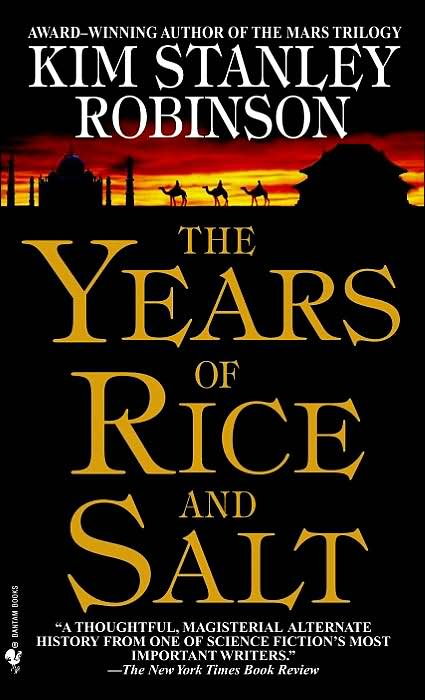
- An alternate history where the Black Death wipes out
virtually
all of
Europe.
The main characters are reincarnated through the ages. After
dying,
they always end up in the bardo. Occasionally, they avoid
drinking
the potion that makes them lose their memories before heading back to
Earth.
- While scouting for Temur The Lame, Bold Bardash reports
that
plague has
destroyed the Magyar kingdom. Bold escapes being killed by
Temur
and wanders the dead cities until being captured by slavers.
He
is
sold to the Chinese fleet of Zheng He and befriends Kyu. Kyu
and
Bold are victims of the power struggles between the Emperor and the
eunuchs.
- Kokila and Bihari are young girls in a small village in
India.
- 115: Kya, the Tigress, saves the life of
Bistami.
While
serving
Akbar,
Bistami is exiled to Mecca. He discusses philosophy with
other
Sufis.
- 133: In a previous incarnation, Bistami was a servant
of
the
Twelfth
Imam.
- 157: Sultan Mawji Darya and Sultana Katima lead a band
of
outcasts up
the
Iberian peninsula to create a utopian city. Katima opens a
madressa
while Ibn Ezra investigates the natural sciences.
- 184: When Sultana Katima is about to confront invaders,
Bistami
warns
her
that she will be killed as in a previous life.
- While invading Nippon for the glory of Chinese Wanli
Emperor,
Admiral
Kheim’s
fleet is swept away to the New World where they meet the
Miwok.
Their
doctor, I-Chin, recommends teaching Mandarin to a young girl,
Butterfly.
Peng gives smallpox to the natives. Heartbroken, the Chinese
leave,
but Peng swam ashore. Later it is learned that Peng help to
inoculate
the entire continent. They travel south, to a gold-laden
empire.
While escaping with Butterfly, Kheim starts to enjoy the power derived
from his pistols. Just before arriving home, Butterfly is
killed
in a storm.
- In central Asia, the alchemist Khalid has a hand
chopped
off for
trying
to fool Sayyed Abdul Aziz. He gives up alchemy in favor of
the
scientific
method. Together with Bahram and Iwang, they make great
progress
in the natural sciences and weapons technology, but are laid low by
plague.
- 372: Busho escaped Nippon to Turtle Island (North
America)
after
the
Chinese
invaded. Traveling east, he acquires the name
Fromwest. He
arrives at the Hodenosaunee Long House to discuss government with the
natives.
- 384 - 385: Fromwest describes how Peng traveled east
and
inoculated the
natives from smallpox.
- The Widow Kang takes in a traveling monk, Bao Ssu-nen
and
his
son.
Bao is accused of cutting off queues, and is tortured and
killed.
Defying all expectation, the Widow Kang marries a Muslim, Ibrahim, and
they move west, to central Asia.
- 402 & 432: Life stages: milk teeth,
hair-pinned-up,
marriage,
children,
rice and salt, and widowhood.
- The doctor of the Sultan, Ismail, witnesses the capture
of
Konstantiniyye
by the Travancore league, from India. Ismail is invited to
Delhi
to meet the abbess Bhakta, with whom he corresponded on medical
matters.
He meets The Kerala, the man responsible for the astounding
technological
and military ascendance of Travancore.
- 538: The flooding at Gold Mountain is an opportunity
for
the
Nipponese
settlers of the Gold Gate, and for Nippon itself, to revolt against the
Chinese. The young servant Kiyoaki is excited to work against
his
Chinese mistress.
- 549: The Long War lasted for the better part of a
century.
The
war
began as Dar al-Islam fought China. Travancore and
Hodenosaunee
were
swept up, creating a global conflict.
- 554: Three Chinese, Bai, Kui, and Iwa, are trapped in
the
seemingly
endless
trench warfare.
- 603: Scheherazade is the fictional storyteller of 1001
Arabian
Nights.
Every night, she told a story to, King Shahryar, but kept the ending in
suspense to stay alive one more day.
- 604: In post war Firanja (Europe), the young Muslim
girl
Budur
moves in
with her liberal aunt Idelba and takes a college course taught by a
radical
woman named Kirana.
- 616: Ibn Khaldun wrote the earliest critical study of
history in Muqaddimah
(1377).
- 642: Idelba is involved in a conspiracy to split the
alactin.
They
eventually conclude that nuclear energy and weapons are not practical.
- 677: Badur attends an international conference of
scientists.
These
conferences started with developing international systems of weights
and
measures, even beginning a new calendar. Eventually this
evolves
into a de facto world government.
- 695: One session is about a village in Tibet that was
covered by
an
avalanche.
A message names several village members, who are all possibly
incarnations
of the main characters.
- 709: Bao Xinhua and Kung Jianguo fight for personal
liberty
in
China.
Kung was assassinated while meeting with another revolutionary leader,
Zhu Isao.
- 738 - 739: Years later, after Bao has retired, he
attends a
class
taught
by an elderly Zhu Isao. They discuss the collection-of-lives
genre
including “The Autobiography of the Wandering
Jew”. In some
literature,
the names all beginning with the same sound is not to be taken
literally,
but is merely a device.
- 761:
All was at peace. Bao wished for
a second that Kung had lived to see
this scene. He had fought for something like this little age of peace,
fought so full of anger and hilarity; it seemed only fair that he
should
have gotten to see it. But—fair. No. No, there would be
another Kung in
the village someday, perhaps that little girl, suddenly so intent and
serious.
Certainly they were all repeated again and again, the whole cast: in
every
group a Ka and a Ba, as in Old Red Ink’s anthology, Ka always
complaining
with the kaw of the crow, the cough of the cat, the cry of the coyote,
kaw, kaw, that fundamental protest; and then Ba always Ba, the banal
baa
of the water buffalo, the sound of the plow bound to the earth, the
bleat
of hope and fear, the bone inside. The one who missed the missing Da,
and
felt the loss keenly, if intermittently, distracted by life; but also
the
ones who had to do whatever possible to keep things going in that
absence.
Go on! The world was changed by the Kungs, but then the Baos had to try
to hold it together, baaing their way along. All of them together
playing
their parts, performing their tasks in some dharma they never quite
understood.
- One of the students in Bao’s class is a
rebellious-looking girl
named
Kali.
FASHIONABLE
NONSENSE
Postmodern Intellectuals’ Abuse Of Science
(1998)
Hardcover
Picador USA, New York
2004-02-30 to 2004-03-01

- Originally Published in France as Impostures
Intellectuelles.
- The story behind this book began with Sokal submitting
a
parody
of
meaningless
new age fluff and pseudoscience entitled “Transgressing the
Boundaries:
Toward a Transformative Hermeneutics of Quantum Gravity” to
the Duke
University
journal Social Text, which they published in 1996.
- 7 - 8: On the contention that these quotations are
marginal:
When ideas are accepted on the basis of
fashion or
dogma,
they are especially sensitive to the exposure even of marginal aspects.
For example, geological discoveries in the eighteenth and nineteenth
centuries
showed that the earth is vastly older than the 5000-or-so years
recounted
in the Bible; and although these findings directly contradicted only a
small part of the Bible, they had the indirect effect of undermining
its
overall credibility as a factual account of history, so that nowadays
few
people (except in the United States) believe in the Bible in the literal
way that most Europeans did only a few centuries ago. Consider, by
contrast,
Isaac Newton’s work: it is estimated that 90 percent of his
writings
deal
with alchemy or mysticism. But, so what? The rest survives because it
is
based on solid empirical and rational arguments. Similarly, most of Descartes’
physics is false, but some of the philosophical questions he raised are
still pertinent today.
- 12 ftnt: Noam Chomsky is often challenged on his
credentials to
comment
on social issues. He writes:
Compare mathematics and the political
sciences—it’s
quite striking. In mathematics, in physics, people are concerned with
what
you say, not with your certification. But in order to speak about
social
reality, you must have the proper credentials, particularly if you
depart
from the accepted framework of thinking. Generally speaking, it seems
fair
to say that the richer the intellectual substance of a field, the less
there is a concern for credentials, and the greater is the concern for
content.
- 39 ftnt: Julia Kresteva seems to subscribe to the
“Sapir-Whorf
thesis”
that language radically conditions our view of the world. Pinker,
for example, criticizes this theory.
- 61: Karl Popper writes in The Logic
of
Scientific Discovery
that true science must be falsifiable.
- 71 -78: Discussion of Thomas Kuhn’s work,
including The
Structure
of Scientific Revolutions.
- 78: Paul Feyerabend criticizes science in works such as Farewell
to Reason, but does not go as far as other
irrationalists.
- 110: Luce Irigaray wrote an essay entitled
“The
‘Mechanics’ of
Fluids”
claiming that fluid mechanics has not been worked on as thoroughly as
solid
mechanics because solidity relates to men and fluidity relates to
women.
- 121: Feminist writer Suzanne Damarin, who writes
approvingly of
Irigaray,
says that the “female mind-body” has difficulty
with geometry.
- 141 - 142: The idea that mathematical systems (such as
weather)
are
extremely
sensitive to initial conditions, a foundation of chaos theory, was
discussed
by James Clerk Maxwell in 1877 and Henri Poincaré in 1909.
- 153: End of chapter on Jean
Baudrillard:
In summary, one finds in
Baudrillard’s work a
profusion
of scientific terms, used with total disregard for their meaning and
above
all, in a context where they are manifestly irrelevant. Whether or not
one interprets them as metaphors, it is hard to see what role they
could
play, except to give an appearance of profundity to trite observations
about sociology or history. Moreover, the scientific terminology is
mixed
up with a non-scientific vocabulary that is employed with equal
sloppiness.
When all is said and done, one wonders what would be left of
Baudrillard’s
thoughts if the verbal veneer covering it were stripped away.
- 211: What can come after post-?
- 259: David Lodge defines a law of academic life: it
is
impossible
to
be excessive in flattery of one’s peers.
- 265: G. H. Hardy, who took pride in working in
mathematical
fields with
no applications, predicted in 1941 that number theory and Einstein’s
relativity would never have military applications.
IN
THE
SHADOW OF
THE GARGOYLE (1998)
Paperback
Ace Books, New York
2004-01-26 to 2004-03-07
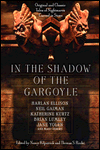
- This is an anthology of short stories dealing with
gargoyles,
although
the relation to some stories is tentative. There is a wide
range
of style and audience.
How Do You Think It Feels by Neil
Gaiman
- This one is serious, including explicit sex scenes, as
contrasted
with
the very next story.
The Gargoyle’s Shadow by
Katherine Kurtz
- This could best be described as juvenile.
Scylla and Charybdis by Don
D’Ammassa
- 48: If I had to pick a favorite, it would be this
one.
However,
even
this story had its flaws.
- 101: According to legend, a nun carved the Little Dedo
statue at
Notre
Dame.
Now Entering Monkeyface by Marc
Levinthal and John Mason
Skipp
- 187: deals with the Cydonia face on Mars.
- 206 & 210: Sheela-na-gig are exaggerated
Medieval
carvings of
female
exhibitionists.
- 246: About gargoyles coming to life and immediately
killing
everyone in
the most gruesome ways possible. This story was not clever at
all,
just an absurd description of meaningless carnage.
GHOST
WARS
The Secret History Of The CIA, Afghanistan, And Bin
Laden,
From The
Soviet
Invasion To September 10, 2001 (2004)
Hardcover
The Penguin Press, New York
2004-03-02 to 2004-03-14
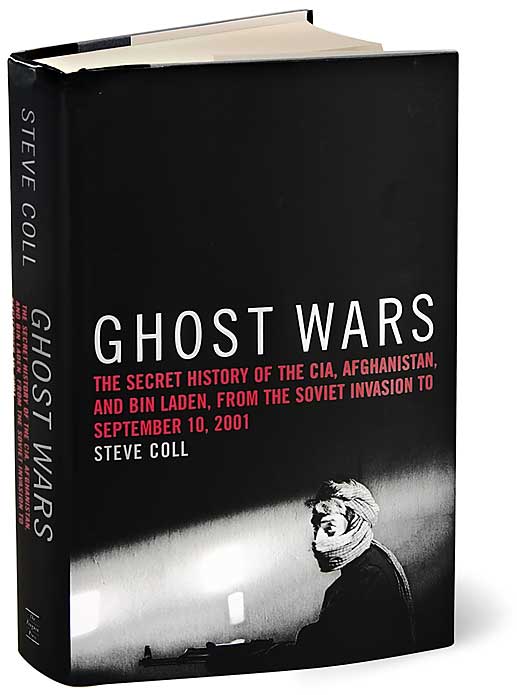
- 5: Mir Amal Kasi killed two and wounded three CIA
employees
on
January
25, 1993, then fled to Pakistan. The few CIA agents in the
region
in 1996 were dedicated to tracking him rather than reporting on the
Taliban.
- 11: Between 2,000 and 2,500 Stinger missiles had been
given
the
the
Mujahedin
in Afghanistan. Presidents H. W. Bush and Clinton instituted
a
highly
classified buy back program of between $80,000 to $150,000 per missile.
- 12: Gary Schroen was sent by the CIA to reopen contact
with
Ahmed
Shah
Massoud, hoping to fund him by buying his Stingers. Schroen
was
shocked
to discover that only 8 missiles had ever been delivered to Massoud,
despite
his reputation as the fiercest anti-Soviet leader. The CIA
confirmed
that Pakistan had funneled most missiles to their favored factions.
- 17: Soviets referred to the CIA-supplied Afghan rebels
as duhki
= ghosts.
- 27 - 28: Conspirators against the Saudi government
massacred
dozens of
pilgrims in Mecca’s Grand Mosque on November 20,
1979. Saudi
Arabia
tried to keep the incident as quiet as possible. Despite
being
perpetrated
by radical muslims, rumors blamed the United States and Israel.
- 27 - 34: The rumors about U.S. involvement in the Grand
Mosque
attack
contributed
to a riot which nearly destroyed the United States embassy in
Islamabad,
Pakistan on November 21, 1979. The Pakistani military dragged
its
heels to restore order, thinking that the staff (including Gary
Schroen)
could not have survived, while Marine Stephen Crowley lay dying.
- 30 -31: A Pakistani police lieutenant pretended to go
along
with
the
protesters
but drove the staff’s families to safety, preventing them
from being
taken
hostage.
- 60 & 63: The CIA generally did not play
favorites
when
providing
assistance
to the Mujahedin, leaving Pakistani dictator General Mohammed
Zia-ul-Haq
to manipulate the funding to fit Pakistan’s goals.
He instructed
Akhtar Abdur Rahman, director-general of the Inter-Services
Intelligence
(ISI) not to be too effective in attacking the Soviets, lest it turn
its
eye toward Pakistan.
- 65: The Saudi royal family matched the CIA in funding
the
Mujahedin,
dollar
for dollar.
- 75: During their ascension in the early part of the
Twentieth
Century,
the al-Saud family became allied with desert preacher Mohammed ibn
Abdul
Wahhab, founder of the strict Wahhabi doctrine.
- 91: Texas Democratic Representative Charlie Wilson
championed the
CIA
war
in Afghanistan, subscribing to a romanticized view of the
Mujahedin.
He often traveled to the region to impress his girlfriends.
- 96 - 97: CIA Director William Casey was notorious for
mumbling.
Many
people, including Reagan and Bush, could not understand a word he said
when giving briefings about critical issues.
- 100: On the changes in foreign policy between
administrations:
Zia told Casey that being an ally
of the United States was like
living
on the banks of an enormous river. “The soil is wonderfully
fertile,”
he
said, “but every four or eight years the river changes
course, and you
may find yourself alone in a desert.”
- 118 -119: Massoud negotiated a (short-lived) truce with
the
Soviets in
the spring of 1983. Because the U.S. and Pakistan wanted war
more
than peace, this helped strengthen his rival Hekmatyar.
- 128: In the 1980s, the CIA and KGB settled into an
unwritten
agreement
not to murder and kidnap each other’s salaried officers.
- 134: Mujahedin fighters did not advocate suicide
attacks,
unlike
Arab
volunteers
later.
- 134 - 135:
Afghan fighters also often refused to
attack bridges
or trade routes if they were important to civilian traders or farmers.
The Afghan tolerance of civilian commerce in the midst of dire conflict
frustrated visiting Americans. A congressman on tour would fly over
Afghanistan,
see a bridge standing unmolested, and complain loudly on his
return
to Washington that it ought to be blown up. But when the
satellite-mapped
attack plan was passed down through ISI to a particular Afghan commando
team, the Afghans would often shrug off the order or use the supplied
weapons
to hit a different target of their own choosing. The livelihood of
their
clan often depended on open roads.
- 160: The U.S. would not work with Gorbachev to
stabilize
Afghanistan.
- 162 - 163: Osama bin Laden and fifty Arab volunteers
held
out for
a
week
against the might of the Soviet army in April 1987 at the fortified
cave
compound at Jaji. More than a dozen of his men were killed
and he
suffered a foot wound. Coverage by Arab journalists
solidified
his
reputation as a warrior.
- 169:
The CIA director [Robert Gates] bet
Armacost $25
that
the Soviets would not be out of Afghanistan before the end of the
Reagan
administration. A few months later he paid Armacost the money.
- 175: After the Soviet withdrawal, Pakistani President
Zia
announced
openly
that he would continue to meddle into internal Afghan affairs.
- 176 -177: The CIA traded a half dozen Toyota pickup
trucks
and
some
BM-12
rockets with the ISI for a captured Soviet SU-25 aircraft.
The
Soviet
pilot, Alexander Rutskoi, declined the usual CIA defection
offer.
Years later he lead an uprising against Boris Yeltsin.
- 182: Ahmed Shah Massoud’s older half-brother
Dean
Mohammed was
killed
after
applying for a visa in Peshawar. ISI’s Afghan cell
was suspected.
- 195 - 199: State Department official Ed McWilliams
disagrees with
the
CIA
policy of supporting anti-American Afghan factions, but his warnings
were
ignored.
- 204: Osama bin Laden names his network al Qaeda.
- 222 - 223: A senior Saudi prince and theologian Khalil
A.
Khalil
met
with
bin Laden in Jedda. Bin Laden demanded a meeting with the
king to
argue for using his own army against Saddam Hussein’s
Iraq. He
was
not permitted to meet with the king but was allowed to pitch to Saudi
Arabia’s
Defense Minister, Prince Sultan.
- 226: In the aftermath of Operation Desert Storm, the
CIA
shipped
abandoned
Iraqi T-55 and T-70 tanks, armored personnel carriers, and artillery
pieces
to Pakistan, where the ISI supplied them to Jallaladin Haqqanni,
Hekmatyar,
and the Arab volunteers for use against Najibullah’s Afghan
army.
Despite the refusal of Hekmatyar and Sayyaf to publicly support Saudi
Arabia
against Iraq, Saudis still secretly gave them cash.
- 228:
All this detailed intelligence reporting
about
international
Islamic radicalism and its sanctuary in Afghanistan gathered dust in
the
middle levels of the bureaucracy. The Gulf War, the reunification of
Germany,
the final death throes of the Soviet Union—these enormous,
all-consuming
crises continued to command the attention of the Bush
administration’s
cabinet. By 1991, Afghanistan was rarely if ever on the agenda.
A senior CIA operative who had worked on
the
anti-Soviet
jihad found himself talking in passing about the Afghan war with
President
Bush. The president seemed puzzled that the CIA’s covert
pipeline
through
Pakistan was still active, as the officer recalled it. Bush seemed
surprised,
too, that the Afghans were still fighting. “Is that thing
still going
on?”
the president asked.
- 232: Secretary of State James Baker and Soviet Foreign
Minister
Boris
Pankin
pledge to cut off arms to Najibullah and the Afghan rebels on January
1,
1992.
- 236 - 237: Convinced that he would control Kabul by
morning,
Hekmatyar
turns off his radio and goes to sleep. He awoke to discover
that
Massoud and Dostum had outmaneuvered him.
- 252: During the Gulf War, Saddam Hussein had sent
two-man
terrorist
teams
to strike at American targets. The agents were issued
passports
with
sequential numbers and were captured.
- 264: Bill Clinton does not sent Agency for
International
Development
(AID)
funds to Afghanistan, in favor of the neediest African countries.
- 269: In 1994 four Arab volunteers tried to assassinate
Osama bin
Laden
for not being pure or radical enough.
- 283 & 285: The Taliban hinted that they might
bring
back the
exiled
King Zahir Shah.
- 337: About 600 of the 2,300 Stinger missiles were still
missing
by the
time the Taliban took Kabul. Prices ranged from $70,000 to
$150,000
per missile.
- 379: A group of Afghans hired for a “snatch
operation” claim to
have
almost
captured bin Laden in 1998.
- 396: CIA director Tenet never presented the Tarnak Farm
raid plan
to
Clinton
because it had a very low chance of success.
- 403 - 404: American embassy bombings at Nairobi, Kenya
and
Dar es
Salaam,
Tanzania on Friday, August 7, 1998.
- 411: Osama bin Laden may have missed the retaliatory
Tomahawk
missile
strike
by a few hours. 75 missiles (at $750,000 each) struck Zawhar
Kili.
- 421: Senior members of the CIA were not informed that
submarines
were
placed
off the coast of Pakistan to send cruise missiles, should bin Laden be
spotted.
- 421 - 422: When Clinton sent cruise missiles against
the
Iraqi
intelligence
headquarters in 1993, one missile had fallen short and killed a
prominent
female Arab artist.
- 456 - 457: Uzbek radicals, supported by bin Laden,
attempted to
kill
president
Islam Karimov with six car bombs on February 16, 1999, killing sixteen
people. Karimov arrested at least two thousand Islamic activists in
retaliation.
- 460: While Hamid Karzai tried to negotiate with the
Taliban, his
father
was assassinated.
- 476: Perez Musharraf plans and executes the seizure of
the
strategic
Kargil
height in Kashmir by Pakistani soldiers disguised as
jihadists.
This
could have sparked a war between India and Pakistan, now both nuclear
powers.
- 478 - 479: Nawaz Sharif tries to replace General
Musharraf
while
he was
flying to Pakistan on October 12, 1999. Musharraf takes over
the
government. Meanwhile, a secret commando team organized to
capture
bin Laden dissolves overnight.
- 482: Jordanian police arrest two Islamists who planned
to
destroy
the
Radisson
Hotel and release cyanide inside a movie theater during the millennium
celebration.
- 483: A team of suicide bombers tried to attack the USS Sullivans
in a similar manner to the USS Cole, but the
overloaded boat
sank
and they were not noticed.
- 491: Hundreds of civilians, related to
Massoud’s
commanders, were
massacred
by the Taliban on the Shomali Plains, yet the Americans never talked
about
it.
- 515: Karzai and Massoud’s aids traveled to
Washington in the
summer of
2000 to plead with Congress for support. Hardly and congress
members
paid any attention. At a typical meeting, perhaps one or two
staff
members would attend.
- 532: The attack on the USS Cole
killed
17 American
sailors and
wounded
30 more. CIA analysts determined that the bombers might
easily
have
killed 300 and sunk the Cole.
- 543: Joint Chiefs Chairman Hugh Shelton brought back
the
cruise
missile
submarines off Pakistan during the transition to the George W. Bush
administration.
- 576: The CIA leaked the death of Massoud to CNN.
LONE
WOLF & CUB
(1970)
Trade Paperbacks
Dark Horse Comics
re-read complete series 2004




























BODY
OF SECRETS
Anatomy Of The Ultra-Secret National Security Agency From
The
Cold
War
Through The Dawn Of A New Century (2001)
Hardcover
Doubleday, New York
2004-03-21 to 2004-04-06
paperback:
“In God we trust, all others we
monitor”
—Intercept operator’s motto
- Chapters are named for their metaphorical parts of the
body:
Memory,
Fat,
Muscle, etc. Each chapter begins with some encrypted text.
- 16 - 17: At the end of WWII, Germans turned over their
Russian
code-breaking
equipment (TICOM) to the U.S. and British. This was a major
help
to the allies, because they had focused their research on breaking
German
and Japanese codes.
- 23: Suddenly in 1948 the Americans were no longer able
to
read
Soviet
messages,
in what became known as Black Friday.
- 28 - 29: Intercepted clues (in retrospect) indicated
that
the
Chinese
would
intervene in the Korean conflict.
- 35: President Eisenhower authorized the boldest
espionage
operation
against
the Soviet Union in the spring of 1956. Project Homerun sent
daily
flights of reconnaissance bombers into Soviet airspace.
- 38: The bomber overflights, a heavily-guarded secret
until
recently,
caused
the loss of more than 200 Americans and more than 40 aircraft during
the
Cold War.
- 40:
Soon after Nasser nationalized the
canal, Britain
joined
France in an ambitious plot to take back the canal by force. Rather
than
appear as an aggressor, however, France secretly enlisted the help of
Israel.
The intrigue involved Israel launching a war against Egypt. Then, once
Egypt began defending itself, England and France would go in as
“peacekeepers.”
As part of the “peace,” the canal would be taken
from Egypt and kept by
Britain and France. Israel would capture the Sinai from Egypt. It was a
deceitful plan, which smacked of a return to the worst days of
colonialism.
Nevertheless, it was fully agreed to by Israeli prime minister David
Ben-Gurion,
defense minister Shimon Peres, and armed forces chief Moshe Dayan.
Britain’s
prime minister, Anthony Eden, informed of Israel’s planned
key role,
likewise
gave his country’s approval. For all involved in the cabal,
it was
essential
to keep the precise details of the elaborate conspiracy hidden from
Washington.
At the same time, however, it was also essential to win
Washington’s
support
once the hostilities began.
- The NSA had relied on Israeli intelligence in the
region,
which
suddenly
became silent.
- 58 & 61: Eisenhower suborned perjury when his
Cabinet members
testified
about the secret Soviet overflights to hide his direct involvement.
- 68: Four retired generals wrote critically of
Eisenhower.
He
looked
into the idea of recalling all four to active duty to court-martial
them.
- 71: The Joint Chiefs of staff developed a plan to stage
an
attack
on
the
United States troops at Guantánamo Bay and frame
Cuba.
General
Lemnitzer, Joint Chiefs Chairman, gave approval just before Eisenhower
left office.
- 77: During the disastrous Bay of Pigs invasion, the
Navy
offered
to
evacuate
Brigade Commander Pepe San Roman, who refused.
- 79: Robert McNamara relieved Major General Edwin A.
Walker
of
command
for
indoctrinating his troops with John Birch Society propaganda.
Walker
protested the enrollment of a black student in Oxford, Mississippi in
September
1961. Robert Kennedy arrested him for seditious conspiracy,
insurrection,
and rebellion, for which he was jailed five days.
- 82:
According to secret and long-hidden
documents
obtained
for Body of Secrets, the Joint Chiefs of Staff drew
up and
approved
plans for what may be the most corrupt plan ever created by the U.S.
government.
In the name of anticommunism, they proposed launching a secret and
bloody
war of terrorism against their own country in order to trick the
American
public into supporting an ill-conceived war they intended to launch
against
Cuba.
Codenamed Operation Northwoods, the
plan, which
had the written approval of the Chairman and every other member of the
Joint Chiefs of Staff, called for innocent people to be shot on
American
streets; for boats carrying refugees fleeing Cuba to be sunk on the
high
seas; for a wave of violent terrorism to be launched in Washington,
D.C.,
Miami, and elsewhere. People would be framed for bombings they did not
commit; planes would be hijacked. Using phony evidence, all of it would
be blamed on Castro, thus giving Lemnitzer and his cabal the excuse, as
well as the public and international backing, they needed to launch
their
war.
- 89: The Joint Chiefs planned more
“pretext” operations against
Cuba
even
after Lemnitzer left:
The report even suggested secretly
paying someone in
the Castro government to attack the United States: “The only
area
remaining
for consideration then would be to bribe one of Castro’s
subordinate
commanders
to initiate an attack on [the U.S. naval base at]
Guantanamo.” The act
suggested—bribing a foreign nation to launch a violent attack
on an
American
military installation—was treason.
- 101: Signal Intelligence ships, such as the Oxford,
used
a
moon-bounce
dish to communicate, which only worked about 12-hours a day, when the
moon
was in sight.
- 125 - 126: Following the Cuban missile crisis, the NSA
did
everything
it
could to keep Cuban radios working, including secretly selling them
spare
parts!
- 160: As early as WWII, U.S. intelligence realized that
the
East
African
desert of Eritrea had optimum “hearability” of
prime targets.
- 164 - 165: The U.S. acquired the island of Diego Garcia
in
the
Indian
ocean
from the British, and forcibly removed the 2,000 residents.
It
remains
a very secure facility.
- 197 - 198: Discussion of lead-up to Israeli attack on
the Liberty,
but not as extensive as in THE
PUZZLE PALACE (1982).
- 201: The Israeli army killed several Indian UN
peacekeepers.
- 212:
As the Israelis continued their slaughter, neither
they nor the Liberty
crew had any idea that witnesses were present high above. Until now.
According
to information, interviews, and documents obtained for Body
of
Secrets,
for nearly thirty-five years NSA has hidden the fact that one of its
planes
was overhead at the time of the incident, eavesdropping on what was
going
on
below. The intercepts from that plane, which answer some of the key
questions
about the attack, are among NSA’s deepest secrets.
- 245 - 282: Discussion of the Pueblo
incident with North
Korea,
also
in THE
PUZZLE PALACE (1982).
- 295 - 297: The Gulf of Tonkin incident, which became
the
pretext
for
U.S.
intervention in Vietnam was based on several lies. The Maddox
mission
was designed to purposely provoke a response, including being timed to
coincide with commando raids, implying that it was supporting them.
- 299: The “unequivocal proof” of
hostile
intentions on August 4,
used by
President Johnson and Secretary of Defense McNamara to pass the Gulf of
Tonkin resolution, turned out to be NSA intercepts from August 2, which
turned out to be no proof at all.
- 306 - 307: Several anecdotes on how poor Communication
Security
(Comsec)
lead to several disasters in Vietnam. Viet Cong radio
intercepted
communication in the clear, and also sent disinformation in English.
- 342 - 343: NSA intercepted a ground-to-missile signal
to
Soviet
SA-2
missiles,
which had been downing dozens of U.S. aircraft. By dissecting
the
signal, the U.S. was able to jam it and save lives, until the enemy
caught
on and changed frequencies.
- 360 - 361: To test the ability to extend the range of
signals by
bouncing,
a rocket containing toxic aluminum oxide and cesium nitrate was
launched
from Eglin Air Force Base in Florida and detonated in the
atmosphere.
The test successfully allowed reception well beyond line of sight.
- 362: Soviet radar signals bounced off the moon and were
received
at
Arecibo.
- 362: NSA developed a way to trick Soviet satellites
into
broadcasting
information.
The system was not used because it would set a bad president.
- 368: Alice Springs, Australia, was chosen as the
location
for the
ground
station Rhyolite satellite, to avoid Soviet interception.
- 370 - 374: Operation Ivy Bells, where the submarine Halibut
tapped
a Soviet underwater cable; also discussed in BLIND
MAN’S BLUFF (1999).
- 375: Despite an embargo, the NSA and Naval Intelligence
smuggled
sensitive
electronic equipment to the racist government of South Africa in return
for intercepts from Russian spy ships and submarines.
- 382: James Guerin, who helped with the smuggling to
South
Africa,
among
many other illegal operations to which the CIA turned a blind eye, was
convicted of masterminding a $1.4 billion fraud.
- 385: The NSA learned about the Iranian hostage rescue
operation
from
intercepted
communication. It warned Air Force General David Jones about
his
poor communication security, and he overcompensated by ordering
complete
radio silence. This inadvertently contributed to the missions
disastrous
failure.
- 386 - 387: NSA director Bobby Inman turned down an
offer to
become
secretary
of defense. Although he denied rumors of homosexuality, some
other
aspect of his private life were problematic.
- 397: Shakespeare mentions the practice of intercepting
mail
in Henry
V:
The King has note of all that they intend,
By interception which they dream not of.
According to information obtained for Body
of
Secrets,
NSA regularly listens to unencrypted calls from suspected terrorist
Osama
bin Laden, in hiding in Afghanistan. Bin Laden uses a portable INMARSAT
phone that transmits and receives calls over spacecraft owned by the
International
Maritime Satellite Organization. This is the same system used by most
ships
and some people who travel to remote locations, such as oil explorers.
According to intelligence officials, Bin Laden is aware that the United
Sates can eavesdrop on his international communications, but does not
seem
to care. To impress cleared visitors, NSA analysts occasionally play
audiotapes
of Bin Laden talking to his mother over an INMARSAT connection.
- 425: Former CIA director R. James Woolsey on European
bribery:
And it’s true that we use
computers to sort through
data by using keywords . . . That’s right, my continental
friends, we
have
spied on you because you bribe. Your companies’ products are
often more
costly, less technically advanced, or both, than your American
competitors’.
As a result you bribe a lot. So complicit are your governments that in
several European countries bribes still are tax-deductible.
One snippet of NSA or CIA information
concerned an
Egyptian
immigrant, Nasser Ahmed, who was seeking asylum in the United States.
The
secret information led to his arrest; he was denied bail and held for
more
than three years in solitary confinement pending his deportation.
Despite
years of efforts by his attorney, Abdeem Jabara, once a subject of
illegal
NSA surveillance himself, he was never told what the “secret
evidence”
consisted of, where it came from, or how the United States obtained it.
In this Kafkaesque
world, he
could
not fight the charges because he was not told what they were: they were
secret. It was only after considerable pressure from the Arab-American
community that the Justice Department finally ordered some of the
information
released. Ahmed was then able to successfully challenge it and win his
freedom.
- Nevertheless, others are still held on
“secret
evidence”, despite
some
judges finding the practice unconstitutional.
- 428 - 429: At the request of the several government
agencies, the
NSA
spied
on U.S. Citizens, including folk singer Joan Baez, Benjamin Spock, Jane
Fonda, and Dr. Martin Luther King, Jr.
- 451: The NSA’s main computer suffered a
massive
failure on Monday
January
24, 2000.
- 465: It is suspected that the Seawolf-class submarine
USS Jimmy
Carter
is intended to tap undersea fiber optic lines, in the same manner that
the Halibut. Tapped copper cables.
- 483: The NSA center, dubbed Crypto City, consumes more
electricity than
Annapolis, with a monthly electric bill of $2 million.
- 485: The culture at NSA includes several interest
groups,
including a
Gay,
Lesbian, or Bisexual Employees club (GLOBE@nsa) named after Alan
Turing, which would have been unthinkable a few years ago.
- 512 - 513: Systems are being developed to share
intelligence
within DoD
better. For example, Air Force Captain Scott
O’Grady was shot
down
over Bosnia in June 1995 because he was never informed of the known
anti-aircraft
missile batteries.
- 526: Frank B. Rowlett, who was one of the original SIS
codebreakers
along
with William Friedman, was head of the crypto team that broke the
Japanese
PURPLE code in 1940.
- 527:
But in 2001, the light of the outside
world was
pushed
even further away as construction continued on one more high fence
stretching
for miles around the entire city. By then Crypto City had become an
avatar
of Jorge Luis
Borges’
“Library
of Babel,” a place where the collection of information is
both infinite
and monstrous, where all the world’s knowledge is stored, but
every
word
is maddeningly scrambled in an unbreakable code. In this
“labyrinth of
letters,” Borges wrote, “there are leagues of
senseless cacophonies,
verbal
jumbles and incoherences.”
- 537: Polygraph testing was first used by the Armed
Forces
Security
Agency
in 1951. The limited statistics on this page from the 1983 to
1984
indicate that many people were rejected as contractors to the NSA
purely
on polygraph results. They make extensive use of EPQs
(Embarrassing
Personal Questions).
- 540: However, polygraphs can extract unexpected
confessions,
according
to the anecdotes here.
- 542: A Department of Energy scientists notes that even
if
the
error
rate
is 2%, 100 innocent people out of 5,000 had their reputations ruined.
- 590 -599: Seymour Cray, inventor of the famous line of
supercomputers,
has a hobby of digging a tunnel beneath his Wisconsin home.
Known
as the “Hermit of Chippewa Falls”, he died in 1996.
QUICKSILVER
Volume One Of The Baroque Cycle (2003)
Hardcover
HarperCollins, New York
2004-05-08 to 2004-06-07
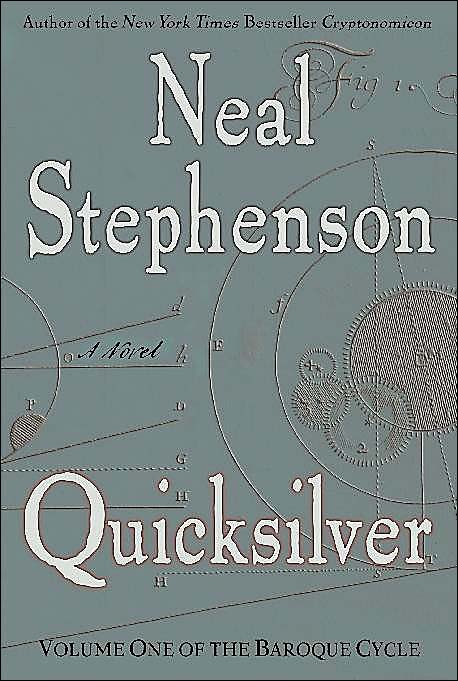
- Enoch Root recruits Daniel Waterhouse to return to
England
from
Boston
Common in 1713, then reminisces about their meeting in 1655, making
Enoch
inexplicably well preserved.
- Several mentions of the CRYPTONOMICON
(1999) by John Wilkins.
- While aboard the Minerva, Daniel
begins
writing his
recollections
on the dispute over the invention of the Calculus, that Newton
described
the “tangents” to him back in 1665.
- 85 - 88: Newton negotiates with a Jewish lens-grinder
over
some
prisms
at Stourbridge Fair. At this time, there really was no such
thing
as standard currency.
“You must have made a
mistake,” said the Jew. “Which
is perfectly all right—we all make mistakes. You reached into
the wrong
pocket and you pulled out your black money*—the stuff you
throw to
beggars.”
“Ahem, er, so I
did,” Isaac said. “Pardon
me—where’s
the money for paying merchants?” Patting a few other pockets.
“By the
way,
assuming I’m not going to offer you black money, how many
shillings?”
“When you say shillings, I
assume you mean the new
ones?”
“The James I?”
“No, no, James I died half a
century ago and so
one would not normally use the adjective new to
describe pounds
minted during his reign.”
“Did you say pounds?”
Daniel asked. “A pound
is rather a lot of money, and so it strikes me as not relevant to this
transaction, which has all the appearances of a shilling type of affair
at
most.”
“Let us use the word coins
until I know
whether
you speak of the new or the old.”
*Counterfeits made of base metals such as copper and lead.
“I have heard that this is the
practice in China,”
Isaac said sagely. “But here in England, a shilling is a
shilling.”
“No matter how little
it weighs!?”
“Yes. In principle,
yes.”
“So when a lump of metal is
coined in the Mint,
it takes on a magical power of shillingness, and even after it has been
filed and clipped and worn down to a mere featureless nodule, it is
still
worth a full shilling?”
“How could it roll when three
of its edges are flat?
It is nearly triangular,” the lens-grinder said.
“A trick of the
light.”
The Jew repeated the biting ceremony,
then scratched
at the coin in case it was a brass clinker japanned with silver paint.
“Worthless. But I owe a shilling to a certain vile man in
London, a
hater
of Jews, and I would drive a shilling’s worth of satisfaction
from
slipping
this slug of pig-iron into his hand.”
- They are interrupted by a man dying of the plague.
- 265: Daniel meets Leibniz.
- 309: Upon discovering that the Ham Bros. Cellar was
empty
while
surrounded
by muttering depositors:
RALEIGH: “I knew it would be
bad. But—my God—there’s
not even a potatoe.”
STERLING: “It is a sort of
anti-miracle.”
LORD HIGH CHANCELLOR OF THE REALM:
“Go up and tell
the musketeers to go and get more musketeers.”
- 369: Jack Shaftoe (a.k.a. Half-Cocked Jack, King of the
Vagabonds)
saves
Eliza.
- 389:
No man was more comprehensively
doomed than him whose chief source
of
gratification was making favorable impressions on some particular
woman.
Like a couple of peasants huddled
together in the
Cathedral
of Notre Dame, Jack and Eliza performed their role in the Mass and then
departed, leaving no sign that they’d ever been there, save
perhaps for
an evanescent ripple in the coursing tide of quicksilver.
- 448: Jack meets Enoch Root, who provides amazingly
accurate
medical
advice
for the era.
- 535: Jack’s syphilis starts to drive him mad.
- 555: Eliza meets stockbroker Aaron de la Vega in
Amsterdam.
- 636: The King is dead. Long live the King!
- 639: Eliza enciphers letters from Versailles with the I
Ching.
- 683 - 684: Daniel asks Newton why God had to be so
oblique
about
Nature.
- 690: Eliza and William of Orange converse on the beach:
“In a way, a slave is
fortunate, because she has more
head-room for
her dreams and phant’sies, which can soar to dizzying heights
without
bumping
up ’gainst the ceiling. But the ones who live at Versailles
are as high
as humans can get, they practically have to go about stooped over
because
their wigs and head-dresses are scraping the vault of
heaven—which
consequently
seems low and mean to them. When they look up, they see, not a vast
beckoning
space above them, but rather—”
“The gaudy-painted
ceiling.”
- 695: Eliza meets Jack’s brother Bob Shaftoe,
who
asks for help
purchasing
his girlfriend, Abigail Frome, from slavery (705).
- 748: Daniel Waterhouse, Nicolas Fatio de Duilliers, and
Eliza are
dinner
guests at the home of Christiaan Huygens.
- 776: Daniel finds himself before the infamous Star
Chamber,
though it
was
abolished by the Long Parliament in 1641.
- 778: Fatio had warned William of Orange about an attack
on
his
person
by
French dragoons:
“Jeffreys! Fatio is a Swiss
Protestant who
warned
the Dutch of a French plot, on Dutch
soil . . .
and
for this you call him a traitor?”
- 785: Sample binary cypher.
- 793: Daniel spends some time in the Tower of
London. His
jailkeeper
is Bob Shaftoe.
- 796: Daniel’s mistress Tess had died a
gruesome
death of smallpox.
- 812: Map of the continent.
- 824: Eliza uses needlework and her native Qwghlm
language
as a
cypher.
What is even more improbable is that someone managed to crack the code.
- 832: The rocking motion of boats betray their cargo.
- Daniel has a blockage in his bladder, which is a death
sentence
if left
untreated, as he witnessed happen to Wilkins (p. 272). Pepys
had
his removed and carries it in his pocket. Daniel’s
Royal Society
friends take it upon themselves to force him to take surgery.
PATTERN
RECOGNITION
(2003)
Hardcover, signed “WM GIBSON”
G. P. Putnams’s Sons, New York
2004-07-08 to 2004-07-13

- Cayce Pollard: Freelance consultant for corporations,
specializing in
logos.
She has a disorder which manifests as a physical aversion to
“bad”
corporate
logos. She scratches off all the brand names from her (bland)
clothes,
turning each into a CPU = Cayce Pollard Unit.
- 78: Upon being confronted with logo trauma, she invokes
the
cadence of
“He took a duck in the face at two hundred and fifty
knots.”
- Blue Ant: Her current client.
- Damien: Her friend in London at whose flat she stays.
- Parkaboy: Fellow devotee of the mysterious films that
have
been
appearing
on the Internet.
- 22:
Homo sapiens is about pattern
recognition, he
[Parkaboy]
says. Both a gift and a trap.
- 29: Cayce mistakes mechanical Curta calculators as
“math
grenades”.
These amazing devices were invented by Curt Herzstark while a prisoner
at Buchenwald.
- 28: Hackers are known as “black
guests”
in China.
- 69: Bigend, founder of Blue Ant, hires Cayce to track
down
the
creator
of the mystery footage, something she has an interest in anyways.
“The heart is a
muscle,” Bigend corrects. “You
‘know’
in your limbic brain. The seat of instinct. The mammalian brain.
Deeper,
wider, beyond logic. That is where advertising works, not in the
upstart
cortex. What we think of as a ‘mind’ is only a sort
of jumped-up gland,
piggybacking on the reptilian brainstem and the older, mammalian mind,
but our culture tricks us into recognizing it as all of consciousness.
The mammalian spreads continent-wide beneath it, mute and muscular,
attending
its ancient agenda. And makes us buy things.”
- 134: Wingrove Pollard: Her intelligence operative
father,
who
disappeared
in Manhattan on September 11, 2001.
DID
ADAM AND
EVE
HAVE NAVELS?
Discourses On Reflexology, Numerology, Urine Therapy, And
Other
Dubious
Subjects (2000)
Hardcover
W.W. Norton & Company, New York
2004-07-13 to 2004-07-17

- 13: Some Young Earth Creationists argue that God
created
light
already
on its way, and that the trees in the Garden of Eden already had tree
rings
that would appear many years old.
- 18: British biologist and liberal Catholic St. George
Mivart
argued in The
Genesis of Species (1871) that God’s help
was needed to
transition
between species. He was excommunicated and denied a Christian
burial
for his trouble. Today, the doctrine of the Catholic Church
regarding
evolution is nearly identical to Mivart’s.
- 25: Philip
Johnson
wrote
an
August 16, 1999 piece in the Wall Street Journal about a Chinese
paleontologist
who disagrees with Darwinian evolution. When confronted,
Johnson
refuses to name the mystery paleontologist.
- 124: Hillary Rodham Clinton had sessions with New Age
guru
(and
channeling
believer) Jean Houston, though they insist that Clinton’s
imaginary
dialogue
with famous dead people were merely mental exercises.
- 131: Apollo 14 astronaut Edgar Mitchell is into the psi
scene,
including
Jean Houston.
- 144: Chapter 14 is devoted to Alan
Sokal’s
hoax article in Social Text.
- 154: H. G. Wells had many hits and misses in his
fictional
accounts of
the future. A remarkable hit was The World
Set Free
(1914) which involves Germany invading France and the creation of
“atomic
bombs” dropped from airplanes.
- 175: Senator Claiborne De Borda Pell from Rhode Island
is
notorious for
being interested in psi phenomena.
- 177: Pell was angry at James
Randi
for a spoon bending performance.
- 199: The self-reinforcing delusions of Marshall Herff
Applewhite
and
Bonnie
Lu Trousdale Nettles (a.k.a. “Bo” and
“Peep”), founders of the Heaven’s
Gate cult, are what psychiatrists call an “insanity of
two”. The
mass suicides in March 1997 were inspired by the arrival a spaceship
supposedly
trailing the Hale-Bopp comet.
- 212: Thomas Edison was once a staunch
materialist.
Eventually, he
became a believer in the afterlife, even to the point of trying to
invent
a device to communicate with the dead.
- 242: It was suggested that Isaac Newton was a repressed
homosexual
regarding
his relationship with Nicolas Fatio de Duillier (see QUICKSILVER
(2003)).
- 269 - 271: Long excerpt from a letter by Darwin
on his gradual disbelief in religion.
the Old Testament was not more to
be trusted than the sacred books
of
the Hindoos.
Some writers indeed are so much impressed with the
amount of suffering
in the world, that they doubt, if we look to all sentient beings,
whether
there is more of misery or of happiness; whether the world as a whole
is
a good or bad one. According to my judgment happiness decidedly
prevails,
though this would be very difficult to prove.
Hence it has come to pass that most or all sentient beings have been
developed in such a manner, through natural selection, that pleasurable
sensations serve as their habitual guides.
“If I will that he tarry till I come, what
is that to
thee?”
- 307: George Gamow described science as an expanding
sphere
on a
sphere;
it reaches a maximum size, after which it starts to contract until no
more
knowledge about the universe remains.
THE
AMAZING
ADVENTURES OF KAVALIER & CLAY (2000)
Paperback
Random House, New York
2004-07-17 to 2004-08-03
2001 paperback:

- Josef Kavalier: Raised in the Jewish Prague Ghetto;
intrigued
with
illusions
and escapism (to the point of almost killing himself). His
parents
pay enormous bribes to allow him to leave the inevitable Nazi
occupation,
but he is sent back. His escape coincides with that of the
famous
Golum of Rabbi Loew.
- Bernard Kornblum: Josef’s magic teacher and
member of the
Hofzinser
Club,
which Josef so desperately wants to join.
- Thomas Masaryk Kavalier: Josef’s younger
brother
whom he spares
no
expense
to try to get to America.
- 37:
Kornblum was, nevertheless, unable to
resist
offering
that final criticism of his erstwhile pupil on his performance that
night.
“Never worry about what you are escaping from,”
he said.
“Reserve
your anxieties for what you are escaping to.”
- Samuel Louis Klayman (a.k.a. Sam Clay):
Josef’s
distant cousin in
Brooklyn.
- 74 - 75: Description of comic books:
In 1939 the American comic book, like
the beavers
and
cockroaches of prehistory, was larger and, in its cumbersome way, more
splendid than its modern descendant. It aspired to the dimensions of a
slick magazine and to the thickness of a pulp, offering sixty-four
pages
of gaudy bulk (including the cover) for its ideal price of one thin
dime.
While the quality of its interior illustrations was generally execrable
at best, its covers pretended to some of the skill and design of the
slick,
and to the brio of the pulp magazine. The comic book cover, in those
early
days was a poster advertising a dream-movie, with a running time of two
seconds, that flickered to life in the mind and unreeled in the
splendor
just before one opened to the stapled packet of coarse paper inside and
the lights came up. The covers were often hand-painted, rather than
merely
inked and colored, by men with solid reputations in the business,
journeyman
illustrators who could pull off accurate lab girls in chains and
languid,
detailed jungle jaguars and muscularly correct male bodies whose feet
seemed
really to carry their weight. Held in the hand, hefted, those early
numbers
of Wonder and Detective, with
their chromatic crew of
pirates,
Hindu poisoners, and snap-brim avengers, their abundant typography at
once
stylish and crude, seem even today to promise adventure of a light but
thoroughly nourishing variety. All too often, however, the scene
depicted
on the label bore no relation to the thin soup of material contained
within.
Inside the covers—whence today there wafts an inevitable
flea-market
smell
of rot and nostalgia—the comic book of 1939 was, in the
beginning, a
necessary,
highly fertile period of genetic and grammatical confusion. Men who had
been reading newspaper comic strips and pulp magazines for most of
their
lives, many of them young and inexperienced with the pencil, the ink
brush,
and the cruel time constraints of piecework, struggled to see beyond
the
strict spatial requirements of the newspaper strip, on the other hand,
and the sheer overheated wordiness of the pulp on the other.
Then, in June 1938, Superman appeared.
He had been
mailed
to the offices of National Periodical Publications from Cleveland, by a
couple of Jewish boys who had imbued him with the power of a hundred
men,
of a distant world, and of the full measure of their bespectacled
adolescent
hopefulness and desperation. The artist, Joe Shuster, while technically
just barely apt, seemed to understand from the first that the big
rectangular
page of the comic book offered possibilities for pacing and composition
that were mostly unavailable in the newspapers; he joined three panels
vertically into one to display the full parabolic zest of one of
Superman’s
patented skyscraper-hops (the Man of Steel could not, at this point in
his career, properly fly), and he chose his angles and arranged his
figures
with a certain cinematic flair. The writer, Jerome Siegel, had forged,
through the smelting intensity of his fanatical love and compendious
knowledge
of the pulps and their antecedents, a magical alloy of several previous
characters and archetypes from Samson to Doc Savage, one with its own
unique
properties of tensility, hardness, and luster. Though he had been
conceived
originally as a newspaper hero, Superman was born in the pages of a
comic
book, where he thrived, and after this miraculous parturition, the form
finally began to emerge from its transitional funk, and to articulate a
purpose for itself in the marketplace of ten-cent dreams: to express
the
lust for power and the gaudy sartorial taste of a race of powerless
people
with no leave to dress themselves. Comic books were Kid Stuff, pure and
true, and they arrived at precisely the moment when the kids of America
began, after ten years of terrible hardship, to find their pockets
burdened
with the occasional superfluous dime.
- Sheldon P. Anapol: President of the Empire Novelty
Company.
Instead
of purchasing ever-increasing advertising space, Sammy makes a pitch to
Anapol to create his own line of comics. Sammy and Josef have
the
weekend to come up with another Superman.
- 93:
“You’re
right,” said Sammy. “The Lion, I don’t
know.
Lions are lazy. How about the Tiger. Tigerman. No, no. Tigers are
killers.
Shit. Let’s see.”
They began to go through the rolls of
the animal
kingdom, concentrating naturally on the predators: Catman, Wolfman, the
Owl, the Panther, the Black Bear. They considered the primates: the
Monkey,
Gorillaman, the Gibbon, the Ape, the Mandrill with his multicolored
wonder
ass that he used to bedazzle his opponents.
“Be serious,” Joe
chided again.
“I’m sorry,
I’m sorry. Look, forget animals.
Everybody’s
going to be thinking of animals. In two months, I’m telling
you, by the
time our guy hits the stands, there’s going to be guys
running around
dressed
like every damn animal in the zoo. Birds. Bugs. Underwater guys. And
I’ll
bet you anything there’s going to be five guys who are really
strong,
and
invulnerable, and can fly.”
- 121: They come up with... the Escapist! He
doesn’t just
fight
crime.
He frees the world of it.
- 131:
And then the man reminded Max,
with a serious but suave and
practiced
air, that freedom was a debt that could be repaid only by purchasing
the
freedom of others.
- 141: In order to qualify as magazines, and therefore be
mailed
second
class,
comic books had to have at least two pages of (usually half-hearted)
prose.
- 156: Anapol brings in George Deasey as editor:
“So it’s to be comic
books, now, is it?” he said to
Anapol as they shook hands. “The devolution of American
culture takes
another
great step forward.” He took his pipe from his hip pocket.
- Anapol accepts, but is afraid to publish the first
issue
with the
cover
with the Escapist providing a right cross to Hitler, even offering more
money if they change the cover. They stick to their guns, and
the
rest is history.
- The Escapist gains superhuman powers, the better to
take on
the
Nazis
(or
their stand-ins). While the Escapist has all but wrapped up
the
War,
Joe feels the need to fight himself, to the point of picking fights
with
random German immigrants. In the meantime, he saves all his
money
in an effort to obtain a visa for his brother.
- 265:
A surprising fact about the magician
Bernard
Kornblum,
Joe remembered, was that he believed in magic. Not in the so-called
magic
of candles, pentagrams, and bat wings. Non in the kitchen enchantments
of Slavic grandmothers with their herbiaries and parings from the
little
toe of a blind virgin tied up in a goatskin bag. Not in astrology,
theosophy,
chiromancy, dowsing rods, séances, weeping statues,
werewolves,
wonders, or miracles. All these Kornblum had regarded as fakery far
different—far
more destructive—than the brand of illusion he practiced,
whose
success,
after all, increased in direct proportion to his audiences’
constant,
keen
awareness that, in spite of the vigilance they could bring to bear,
they
were being deceived. What bewitched Bernard Kornblum, on the contrary,
was the impersonal magic of life, when he read in a magazine about a
fish
that could disguise itself as any one of seven different varieties of
sea
bottom, or when he learned from a newsreel that scientists had
discovered
a dying star that emitted radiation on a wavelength whose value in
megacycles
approximated p. In the
realm of human
affairs,
this type of enchantment was often, though not always, a sadder
business—sometimes
beautiful, sometimes cruel. Here its stock-in-trade was ironies,
coincidences,
and the only true portents: those that revealed themselves,
unmistakable
and impossible to ignore, in retrospect.
- 267: The next logical character is a female superhero:
On this particular autumn night, only
the prospect
of
another solitary evening lies before her. She will fry and chop and
read
herself to sleep, no doubt with a tale of wizardry and romance. Then,
in
dreams that strike even her as trite, Miss Dark will go adventuring in
chain mail and silk. Tomorrow morning she will wake up alone, and do it
all again.
Poor Judy Dark! Poor little librarians
of the world,
those girls, secretly lovely, their looks marred forever by the cruelty
of a pair of big black eyeglasses!
- Luna Moth likes to wear a skimpy costume as she fights
crime.
- Tracy Bacon: Radio voice of The Escapist, and later
Sammy’s
boyfriend.
- 368 - 369: Citizen Kane challenged
comic book writers to
produce
more complex narratives, often told from the point of view of minor
characters.
- Joe Kavalier joins the Army immediately after Pearl
Harbor,
and
is sent
to a listening post in Antarctica. He does not read letters
from
his girlfriend Rosa, who carries his child. After losing
Tracy,
Sammy
marries Rosa and raises Tommy as his own.
- After an absence of many years, Joe reappears to
perform a
death-defying
stunt on the Empire State Building.
- 535: Kornblum told Josef about an incident with Houdini:
“It was Bess
Houdini,” he said. “She knew her
husband’s
face. She could read the writing of failure in his eyes. She could go
to
the man from the newspaper. She could beg him, with the tears in her
eyes
and the blush on her bosom, to consider the ruin of her
husband’s
career
when put into balance with nothing more on the other side than a good
headline
for the next morning’s newspaper. She could carry a glass of
water to
her
husband, with the small steps and the solemn face of the wife. It was
not
the key that freed him,” he said. “It was the wife.
There was no other
way out. It was impossible, even for Houdini.” He stood up.
“Only love
could pick a nested pair of steel Bramah locks.” He wiped at
his raw
cheek
with the back of his hand, on the verge, Joe felt, of sharing some
parallel
example of liberation from his own life.
- Sammy is called to testify before Congress about the
corrupting
influence
of comic books, especially the whispered rumors for why adult
superheroes
have a tendency to take on strapping young lads as their ward sidekicks.
- 585: Joe’s masterpiece is a comic about the
famous Golum:
“I like that one. You know,
your angels look a
little
like superheroes.”
“Well, it’s a comic
book.”
“This is what I’m
thinking.”
“Jewish
superheroes?”
“What, they’re all
Jewish, superheroes. Superman,
you don’t think he’s Jewish? Coming over from the
old country, changing
his name like that. Clark Kent, only a Jew would pick a name like that
for himself.”
THE
LESSONS OF TERROR
A History Of Warfare Against Civilians: Why It Has Always
Failed
And Why
It Will Fail Again (2002)
Hardcover
Random House, New York
2004-08-13 to 2004-08-16
paperback: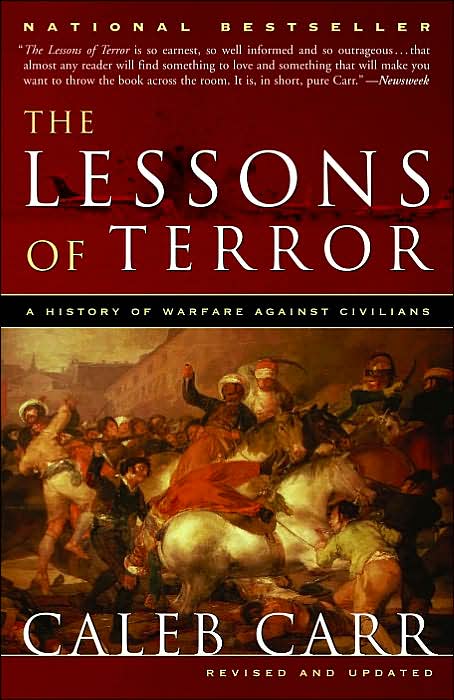
- 13: The response to terrorism:
preemptive military offensives
aimed at making not only terrorists
but the states that harbor, supply, and otherwise assist them
experience
the same perpetual insecurity that they attempt to make their victims
feel.
The methods must be different, of course, for, as stated, terror must
never
be answered with terror; but war can only be
answered with
war,
and it is incumbent on us to devise a style of war more imaginative,
more
decisive, and yet more humane than anything terrorists can contrive.
- 25 - 26: The German commander Arminius led a provincial
revolt
against
Rome, while renouncing the Roman methods of attacking civilians.
- 33: Augustine of Hippo wrote about the concept of a
“just war”.
- 39: Terms of war were spelled out at Toulouges in 1027,
including
the
agreement
that war could only be waged Monday through wednesday, and never during
Advent or Lent. The Council of Narbonne declared in 1054 that
no
Christian should kill another Christian for any reason.
- 51: Erasmus quote:
Dulce bellum inexpertis = War is
sweet to those
who
know nothing
of it.
- 57: Two condittieri, Paolo Vitelli
and
Prospero Colonna,
wrote:
wars are won rather by industry
and cunning than by the actual clash
of arms.
- 71: Cardinal Richelieu’s policy of raison
d’état (“reason
of state”) justified even the most heinous action as long as
it served
France’s interests.
- 80: Thomas Hobbes writes that people will endure pain
in
exchange
for
security.
- 107:
But as they reached this terrible
understanding, the [Eighteenth
Century]
European soldiers and settlers also began to practice those same
tactics,
rationalizing their behavior with the infamous logic that “to
defeat a
savage one must become a savage.” It is an argument, as
already noted,
that is often invoked today in the context of our war against
terrorism;
and it is just as self-serving and hollow now as it was 250 years ago.
- 126: The Total War espoused by Clauswitz in his On
War
would
have
horrified Frederick the Great.
- 160: General Kitchener delighted in using Maxim guns on
Sudanese
warriors
(and women and children) later invented “concentration
camps” during
the
Boer War.
- 190: For a report solicited by Eisenhower, Lieutenant
General
James
Doolittle
writes approvingly of the tactics of the CIA.
- 241- 242:
It would be difficult to imagine a move
that would
send
a more powerful signal to other countries that the United States
intends
to change the way it does global business than abolishing the CIA. But
this should not even be a consideration unless it would heighten rather
than diminish American national security. And we can quickly see that
it
would, first by putting other intelligence agencies on notice that they
are also expendable and had better start doing their investigation,
research,
and analysis jobs better than they were done prior to the September 11
attacks, and second by closing those avenues of threat that the
questionable
loyalties of certain key CIA operatives have kept open.
BEING
AND NOTHINGNESS
(1956)
Translated from the French and with an Introduction by Hazel
E. Barnes
Hardcover
Gramercy Books, New York
2003-10-2 to 2004-08-27
paperback:
- Originally entitled L’Être
et
le néant.
- xlix:
Being is
simply the condition of all revelation. The existent is
being-for-revealing (être-pour-dévoiler)
and not revealed being (être
dévoilé).
- liii:
Heidegger’s
expression: revealing-revealed =
révélante-révélée
- lxii:
The
being-for-itself (l’être-pour-soi)
vs. the being-in-itself (l’être-en-soi)
- lxvi: Being is superfluous (de
trop)
- 14: Hegel states that being and nothingness are
opposites,
as
thesis and antithesis, and the difference between which is only a
simple “opinion”.
- 21: Realities such as absence, change, otherness,
repulsion,
regret, distraction, etc. are inhabited by negation as a necessary
condition for their existence, called négatités.
- 39:
All these trivial passive
expectations of the real, all these
commonplace, everyday values, derive their meaning from an original
projection of myself which stands as my choice of myself in the world.
But there exist more subtle
behaviors, the description of which will
lead us further into the inwardness of consciousness. Irony is one of
these. In irony a man annihilates what he posits within one and the
same act; he leads us to believe in order not to be believed; he
affirms to deny and denies to affirm; he creates a positive object but
it has not being other then its nothingness.
- 48: Attitude that does not direct its negation outward,
but
toward itself is bad faith (mauvaise
foi).
- 55:
Take the example of a woman who has
consented to go
out with a particular man for the first time. She knows very well the
intentions which the man who is speaking to her cherishes regarding
her. She knows also that it will be necessary sooner or later for her
to make a decision. But she does not want to realize the urgency; she
concerns herself only with what is respectful and discreet in the
attitude of her companion. She does not apprehend this conduct as an
attempt to achieve what we call “the first
approach;” that is, she does
not want to see possibilities of temporal development which his conduct
presents. She restricts this behavior to what is in the present; she
does not wish to read in the phrases which he addresses to her anything
other than their explicit meaning. If he says to her, “I find
you so
attractive!” she disarms this phrase of its sexual
background. The man
who is speaking to her appears to her sincere and respectful as the
table is round or square, as the wall coloring is blue or gray. The
qualities this attached to the person she is listening to are in this
way fixed in permanence like that of things, which is no other than the
projection of the strict present of the qualities into the temporal
flux. This is because she does not quite know what she wants. She is
profoundly aware of the desire which she inspires, but the desire cruel
and naked would humiliate and horrify her. Yet she would find no charm
in a respect which would only be respect. ... But then suppose he takes
her hand. ... And during this time the divorce of the body from the
soul is accomplished; the hand rests inert between the warm hands of
her companion—neither consenting nor resisting—a
thing.
We shall say that this woman is in bad
faith. But we
see immediately that she uses various procedures in order to maintain
herself in this bad faith. She has disarmed the actions of her
companion by reducing them to being only what they are; that is, to
existing in the mode of the in-itself. But she permits herself to enjoy
his desire, to the extent that she will apprehend it as not being what
it is, will recognize its transcendence.
- 74: Is this where Ayn
Rand
got this phrase?:
The principle of identity can be
said to be synthetic not only
because it limits its scope to a region of definite being, but in
particular because it masses within it the infinity of density.
“A is
A” means that A exists in an infinite compression with an
infinite
density.
- 76: A reflection (reflet)
which is its own reflecting (reflection).
- 91: Being and consciousness form a dyad.
- 91:
A feeling, for example, is a feeling in
the presence
of a norm; that is, a feeling of the same type but one which would be
what it is. This norm or totality of the affective self is directly
present as a lack suffered
in
the very heart of the suffering. One suffers from not suffering enough.
The suffering of which we speak
is never exactly that which we feel.
- 102: Circuit of selfness (Circuit
de ipséité) = the relation of the
for-itself with
the possible which it is.
- 150: The English word “reflection”
has
two meaning which have
distinct words in French. The
“reflection-reflection” (reflet-reflétant)dyad refers to
that which is
reflected in a mirror. The subject in this section is reflexion, which
means mental
reflection and introspection.
- 216:
This time appears through trajectories. But
just as spatial
trajectories decompose and collapse into pure static spatiality, so the
temporal trajectory collapses as soon as it is not simply lived as that
which objectively implies our expectation of ourselves.
- 221: Shame is not originally a phenomenon of
reflection, it
must
manifest itself in relation to somebody. For example, making
a
vulgar gesture does not lead to shame unless you realize someone else
saw it.
- 222:
Moreover the very notion of vulgarity
implies an inter-monad relation. Nobody can be vulgar all alone!
- 223 -: The Reef of Solipsism.
- 232: Leibniz recourses to God for the Other.
- 290:
Black masses, desecration of the
host, demonic associations, etc.
are so many
attempts to confer
the character of object on the absolute Subject. In desiring Evil for
Evil’s sake I attempt to contemplate the diving
transcendence—for which
Good is the peculiar possibility—as a purely given
transcendence and
one which I transcend toward Evil. Then I “make God
suffer,” I
“irritate him,” etc.
These
attempts, which imply the absolute recognition
of God as a subject who can not be an object, carry their own
contradiction within them and are always failures.
- 338: Defines Nausea, and refers to his book by the same
name.
- 366 - 367:
The notion of
“ownership,” by which love is so often
explained, is not actually primary. Why should I want to appropriate
the Other if it were not precisely that the Other makes me be? But this
implies precisely a certain mode of appropriation; it is the
Other’s
freedom as such that we want to get hold of. Not because of a desire
for power. The tyrant scorns love, he is content with fear. If he seeks
to win the love of his subjects, it is for political reasons; and if he
finds a more economical way to enslave them, he adopts it immediately.
On the other hand, the man who wants to be loved does not desire the
enslavement of the beloved. he is not bent on becoming the object of
passion which flows forth mechanically. He does not want to possess the
automaton, and if we want to humiliate him, we need only try to
persuade him that the beloved’s passion is the result of
psychological
determinism. The lover will then feel that both his love and his being
are cheapened. If Tristan and Isolde fall madly in love because of a
love potion, they are less interesting. The total enslavement of the
beloved kills the love of the lover. The end is surpassed; if the
beloved is transformed into an automaton, the lover finds himself
alone. Thus the lover does not desire to possess the beloved as one
possesses a thing; he demands a special type of appropriation. He wants
to possess a freedom as freedom.
- 405: One of the best explorations of torture and sadism
is
the
end of Faulkner’s Light
in August.
- 441:
This freedom is not a being; it is
the being of man—i.e.,
his nothingness of being. If we start by conceiving of man as a plenum,
it is absurd to try to find in him afterwards moments or psychic
regions in which he would be free. As well look for emptiness in a
container which one has filled beforehand up to the brim! Man can not
be sometimes slave and sometimes free; he is wholly and forever free or
he is not free at all.
One must be conscious in order to
choose, and one must choose in
order to be conscious. Choice and consciousness are one and the same
thing.
- 468: Leibniz had three criteria for freedom. that man
is
free who:
- determines himself rationally to perform an act;
- is such that this act is understood fully by the
very
nature of the one who has committed it;
- is contingent—that is, exists in such a
way
that other
persons committing other acts in connection with the same situation
would have been possible.
- 531:
Thus the bourgeois makes himself
bourgeois by denying that there are
any classes, just as the worker makes himself a worker by asserting
that classes exist and by realizing through his revolutionary activity
his “being-in-a-class.”
“Does history have a
meaning?” That is,
“is history completed or
only terminated?” This question is not resolved. Perhaps it
is
insolvable since all answers which can be made to it (including the
answer of idealism: “The history of Egypt is the history of
Egyptology”) are themselves historical.
In other words human reality
would remain finite even if it were
immortal, because it makes
itself finite by choosing itself as human. To be finite, in fact, is to
choose oneself—that is, to make known to oneself what one is
by
projecting oneself toward one possible to the exclusion of others.
- 576: Three big categories of concrete human existence: to do, to have, to be.
- 615: Last paragraph before conclusion:
Generally speaking there is no
irreducible taste or
inclination. They all represent a certain appropriate choice of being.
It is up to existential psychoanalysis to compare and classify them.
Ontology abandons us here; it has merely enabled us to determine the
ultimate ends of human reality, its fundamental possibilities, and the
value which haunts it. Each human reality is at the same time a direct
project to metamorphose its own For-itself into an In-itself-For-itself
and a project of the appropriation of the world as a totality of
being-in-itself, in the form of a fundamental quality. Every human
reality is a passion in that it projects losing itself so as to found
being and by the same stroke to constitute the In-itself which escapes
contingency by being its own foundation, the Ens causa sui,
which religions call
God. Thus the passion of man is the reverse of that of Christ, for man
loses himself as man in order that God may be born. But the idea of God
is contradictory and we lose ourselves in vain. Man is a useless
passion.
But ontology and existential
psychoanalysis (or the
spontaneous and empirical application which men have always made of
these disciplines) must reveal to the moral agent that he is the being by whom values exist.
It
is then that his freedom will become conscious of itself and will
reveal itself in anguish as the unique source of value and the
nothingness by which the world
exists.
This freedom chooses then not to recover
itself but
to flee itself, not to coincide with itself but to be always at a
distance from
itself.
A
HEARTBREAKING
WORK OF STAGGERING GENIUS
Based On A True Story (2000)
Paperback
Simon & Schuster, New York
2004-09-10 to 2004-10-23
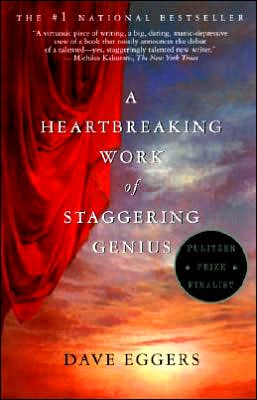
- The content in a nutshell: Dave loses both his parents
from
cancer in
the
span of about a month. Despite being the least responsible of
his
siblings, he takes custody of his younger brother, Toph, and moves to
Berkley,
California.
- The main claim-to-fame of his home town is Mr. T.
- 121 - 123: At a party, he invents an elaborate lie
about
how Toph
is
off
hitchhiking after shooting a schoolmate:
“Don’t tell Moodie
about this.”
“Okay.”
“He’ll
worry.”
- He and some fellow youngsters create the alternative
magazine, Might,
to show off their hipness and brilliance.
- 146: He accuses a group of Mexicans of stealing his
wallet,
but
later
finds
it on his bedroom dresser.
- 161: Interviewing as a potential cast member of The
Real
World: San
Francisco.
- 220: Puck picks up a stray dog (who was probably from
the
neighborhood)
when visiting a Might photo shoot.
- 264: Dave addresses presents to Toph as from God:
“Thank you,” he
says.
“Thank who?”
“I don’t know.
You?”
“No, not me. Jesus.”
“Thank you, Jesus?”
“Yes, Toph, Jesus died for
your Christmas fun.”
“He did?”
- 271: Chapter IX is when Might pulls
off
the practical
joke of
faking
the death of Adam Rich from Eight is Enough (after Robert Urich says
no).
CEREBUS
Dave Sim, Gerhard
Aardvark-Vanheim Press

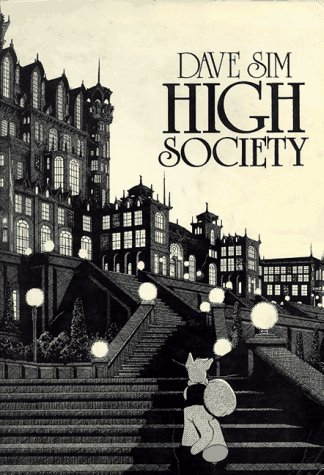
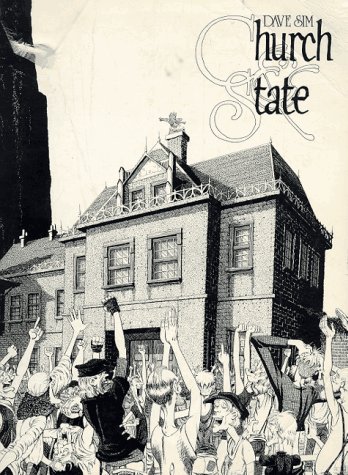
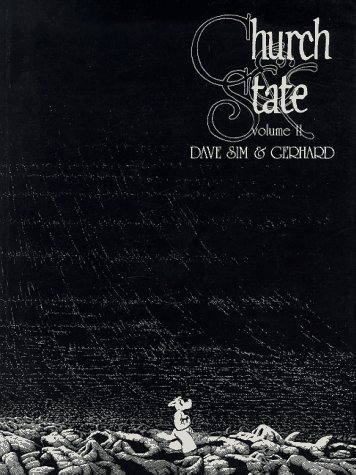
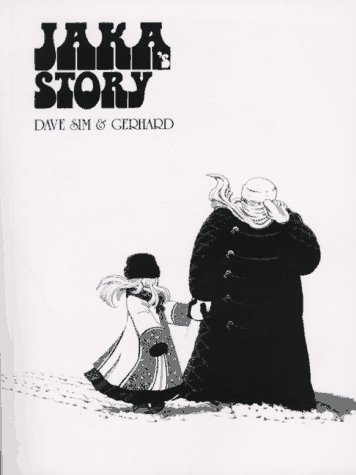
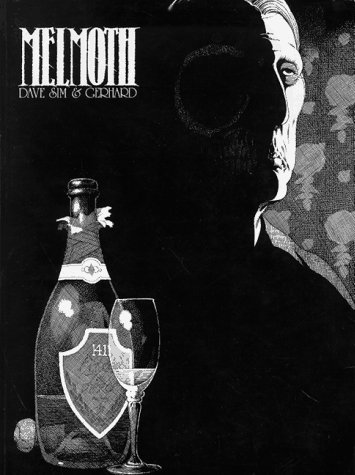
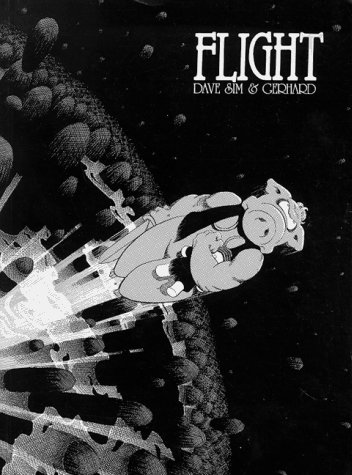

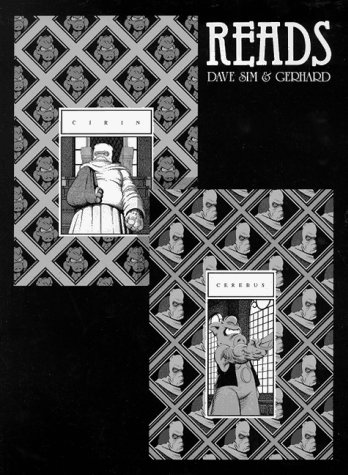
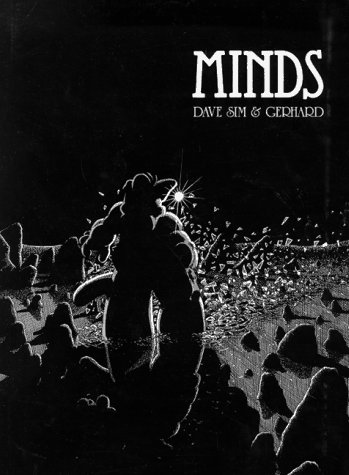
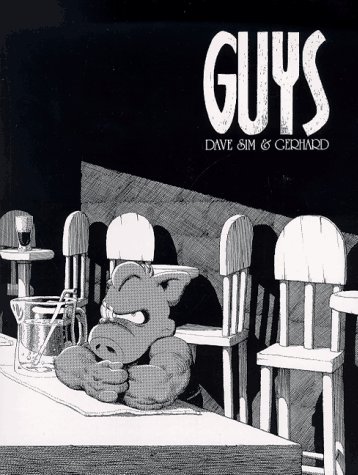
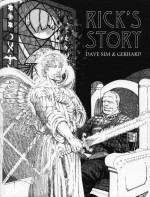


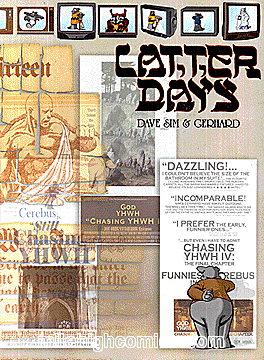

- Cerebus is not to be confused with Cerberus, the five
headed dog
guarding
Hell in Dante’s
Inferno.
-
MUTANTS
On Genetic Variety And The Human Body (2003)
Hardcover
Viking Penguin, New York
2004.11.12 – 2004.11.27
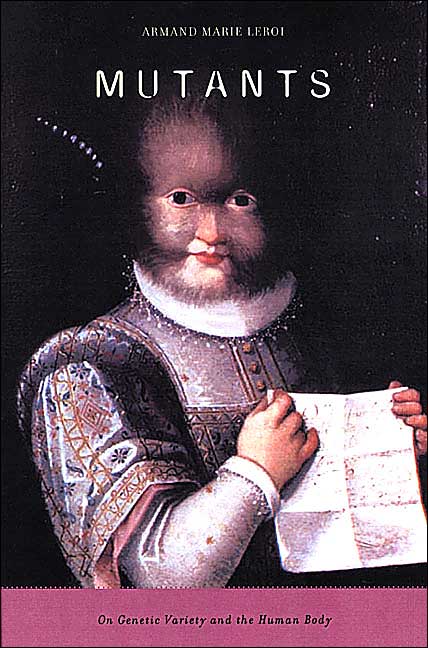
- 8: Teratology = literally, the study of monsters.
- 8: Sir Thomas Brown published an early book debunking
superstitions, Pseudodoxia
epidemica, or, enquiries into very many received tenents and commonly
presumed
truths (1646).
- 18: Every embryo has about 100 mutations that its
parents
did not
have,
about four of which will affect amino acid sequences.
- 19:
Who, then, are the mutants? There
can only be one answer, and it is
one that is consistent with our everyday experience of the normal and
the
pathological. We are all mutants. But some of us are more mutant than
others.
- 53: Parasites differ from conjoined twins merely by
asymmetry.
Cases
where
fully developed individuals have small, under-developed attached
siblings.
- 55 - 56: Situs inversus, a mirror-imaging of internal
organs, is
found
in 50% of side to side conjoined twins, always on the right (from their
perspective). About 1 in 8500 non twins have situs inversus.
- 57 - 58: About half of people with
Kartagener’s
syndrome have
inverted
viscera. Symptoms of Kartagener’s include a poor
sense of smell,
sterility, and susceptibility to bronchial infection due to defective
cilia.
- 158: Osteogenesis imperfecta, known as glass bone
disease,
has
four
forms.
- 194 - 196: Cretenism is caused by iodine deficiency.
- 205 - 206: James Merrick, the “Elephant
Man”, had Proteus
syndrome.
- 231: Birds have W and Z sex chromosomes, rather than X
and
Y.
Females
are WZ and males are ZZ.
- 263 - 264: Rita Hoefling, a white house wife in Cape
Town
South
Africa,
was diagnosed with Cushing’s disease at the age of
40. Her skin
turned
black, and she was shunned by apartheid society. Years later, she
spontaneously
turned white again. She had Nelson’s syndrome, which affects
one third
of patients whose adrenal gland was removed.
- 304 - 305: Alexander Graham Bell compiled lists of
longevity
records in
an attempt to encourage “positive” eugenics.
 MNRay.net
MNRay.net
 MNRay.net
MNRay.net



































































